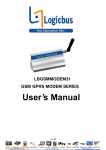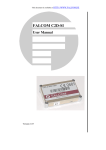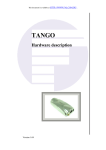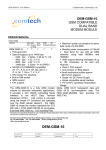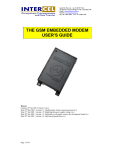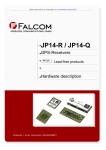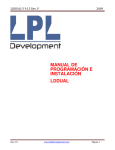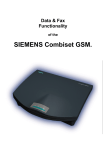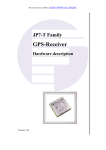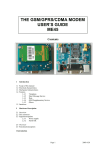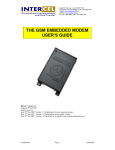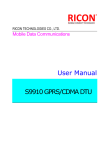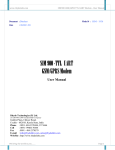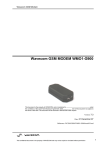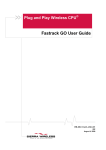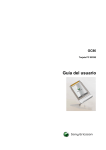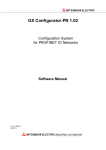Download A3D-JP3 - Falcom
Transcript
This document is available at HTTP://WWW.FALCOM.DE/ . FALCOM A2D-3, A2D-3JP3, A3D & A3D-JP3 User’s Manual Version 1.08 FALCOM A2D-3, A2D-3JP3, A3D & A3DJP3 VERSION 1.08 Contents 0 INTRODUCTION ..............................................................7 0.1 0.2 USED ABBREVIATIONS .....................................................................................................................8 RELATED DOCUMENTS.....................................................................................................................9 1 SAFETY ............................................................................10 1.1 1.2 1.3 1.4 1.5 1.6 1.7 1.8 1.9 1.10 1.11 1.12 1.13 GENERAL....................................................................................................................................10 EXPOSURE TO RF ENERGY ....................................................................................................10 EFFICIENT MODEM OPERATION...........................................................................................10 ANTENNA CARE AND REPLACEMENT................................................................................11 DRIVING .....................................................................................................................................11 ELECTRONIC DEVICES............................................................................................................11 VEHICLE ELECTRONIC EQUIPMENT ...................................................................................11 MEDICAL ELECTRONIC EQUIPMENT ..................................................................................11 AIRCRAFT ..................................................................................................................................11 CHILDREN ..................................................................................................................................12 BLASTING AREAS ....................................................................................................................12 POTENTIALLY EXPLOSIVE ATMOSPHERES.......................................................................12 NON-IONISING RADIATION ...................................................................................................12 2 SAFETY STANDARDS ...................................................13 3 FALCOM A3D & A3D-JP3.............................................14 3.1 3.1.1 3.1.2 3.1.3 3.1.4 3.1.5 3.1.6 3.2 GENERAL DESCRIPTION .................................................................................................................14 Functional overview .....................................................................................................................15 SIM card .......................................................................................................................................15 Serial interfaces ............................................................................................................................15 Multimedia Card (MMC)..............................................................................................................16 LED’s for working state of FALCOM A3D and A3D-JP3 ..........................................................17 Operating by internal Battery .......................................................................................................17 FUNCTIONAL DESCRIPTION ............................................................................................................17 4 TECHNICAL DATA FOR FALCOM A3D AND FALCOM A3D-JP3..........................................................18 4.1 4.1.1 4.1.2 POWER CONSUMPTION ...................................................................................................................18 A3D-900/1800-G10 power consumption .....................................................................................18 A3D-JP3-900/1800-G10 power consumption ..............................................................................19 5 GSM CORE (A3D AND A3D-JP3) .................................20 5.1 5.2 5.3 5.4 5.4.1 5.4.2 5.4.3 5.4.4 5.4.5 5.4.6 GENERAL .......................................................................................................................................20 ELECTRICAL ..................................................................................................................................20 PHYSICAL ......................................................................................................................................20 BASIC FEATURES ...........................................................................................................................20 Telephony .....................................................................................................................................20 Short Message Service (GSM and GPRS mode) ..........................................................................20 GSM circuit Data Features ...........................................................................................................20 GPRS Packet Data Features..........................................................................................................21 GSM Supplementary services.......................................................................................................21 Other features ...............................................................................................................................21 6 GPS CORE (A3D-JP3).....................................................22 6.1 6.2 6.2.1 GENERAL .......................................................................................................................................22 TECHNICAL DATA ..........................................................................................................................22 NMEA data message ....................................................................................................................22 This confidential document is the property of FALCOM GmbH and may not be copied or circulated without permission. Page 2 FALCOM A2D-3, A2D-3JP3, A3D & A3DJP3 VERSION 1.08 7 INTERFACES OF FALCOM A3D AND FALCOM A3D-JP3.............................................................................25 7.1.1 7.1.2 7.1.3 7.1.4 7.1.5 7.1.6 7.1.7 7.1.8 Interface (A) .................................................................................................................................25 Interface (B)..................................................................................................................................25 Interface C ....................................................................................................................................26 Interface D ....................................................................................................................................28 Interface E.....................................................................................................................................29 Interface F.....................................................................................................................................29 SIM interface ................................................................................................................................29 Audio interface G .........................................................................................................................29 8 FALCOM A2D-3 & A2D-3JP3 .......................................30 8.1 8.1.1 8.1.2 8.1.3 8.1.4 8.2 8.3 8.3.1 8.4 8.4.1 GENERAL DESCRIPTION .................................................................................................................30 Functional overview .....................................................................................................................30 SIM card .......................................................................................................................................31 Serial interface ..............................................................................................................................31 LED's for functional display.........................................................................................................31 FUNCTIONAL DESCRIPTION ............................................................................................................32 TECHNICAL DATA FOR FALCOM A2D AND FALCOM A2D-JP3 ................................................32 A2D-3 ...........................................................................................................................................32 POWER CONSUMPTION ...................................................................................................................33 A2D-3-900/1800-G10 power consumption ..................................................................................33 9 GSM CORE (A2D-3 AND A2D-3JP3)............................34 9.1 9.2 9.3 9.4 9.4.1 9.4.2 9.4.3 9.4.4 9.4.5 9.4.6 GENERAL .......................................................................................................................................34 ELECTRICAL ..................................................................................................................................34 PHYSICAL ......................................................................................................................................34 BASIC FEATURES ...........................................................................................................................34 Telephony .....................................................................................................................................34 Short Message Service (GSM and GPRS mode) ..........................................................................34 GSM circuit Data Features ...........................................................................................................34 GPRS Packet Data Features..........................................................................................................35 GSM Supplementary services.......................................................................................................35 Other features ...............................................................................................................................35 10 GPS CORE (A2D-3JP3)...................................................36 10.1 10.2 10.2.1 GENERAL .......................................................................................................................................36 TECHNICAL DATA ..........................................................................................................................36 NMEA data message ....................................................................................................................36 11 INTERFACES OF A2D-3................................................39 11.1 11.2 11.2.1 11.2.2 11.2.3 11.2.4 11.2.5 11.2.6 11.2.7 11.2.8 11.2.9 11.2.10 11.2.11 INTERFACE A.................................................................................................................................39 INTERFACE B.................................................................................................................................39 Electrical parameter of general IO ports.......................................................................................40 Interface C ....................................................................................................................................41 Interface D ....................................................................................................................................42 Interface E.....................................................................................................................................42 SIM interface ................................................................................................................................42 Digital interface ............................................................................................................................42 Audio interface: ............................................................................................................................42 Cable reference for connector 9 pin D-Sub (modem cable) .........................................................42 Cable reference for Input/Output connection: ..............................................................................43 Data protocol ................................................................................................................................43 Short Message Service..................................................................................................................43 12 A2D-3JP3...........................................................................44 This confidential document is the property of FALCOM GmbH and may not be copied or circulated without permission. Page 3 FALCOM A2D-3, A2D-3JP3, A3D & A3DJP3 VERSION 1.08 12.1 12.1.1 12.2 12.2.1 12.2.2 12.2.3 12.2.4 12.2.5 12.2.6 12.2.7 12.2.8 12.2.9 12.2.10 12.2.11 12.2.12 POWER CONSUMPTION ...................................................................................................................44 A2D-3-JP3-900/1800-G10 power consumption ...........................................................................44 INTERFACES OF A2D-3JP3 ............................................................................................................45 Interface A ....................................................................................................................................45 Interface B ....................................................................................................................................45 Interface C ....................................................................................................................................47 Interface D ....................................................................................................................................48 Interface E.....................................................................................................................................48 SIM interface ................................................................................................................................48 Digital interface ............................................................................................................................48 Audio interface .............................................................................................................................48 Cable reference for connector 9 pin D-Sub (modem cable): ........................................................49 Cable reference for Input/Output connection: ..............................................................................49 Data protocol ................................................................................................................................49 Short Message Service..................................................................................................................49 13 COMMAND LIST............................................................50 13.1 13.2 13.3 13.4 13.5 13.6 ESSENTIAL AT-COMMANDS ..........................................................................................................50 GSM AT COMMANDS (GSM 07.07) .............................................................................................51 SMS AT COMMANDS (GSM 07.05)..............................................................................................52 MOBILE EQUIPMENT ERROR RESULT CODE : +CME ERROR: XXX................................................52 MESSAGE SERVICE FAILURE RESULT CODE: +CMS ERROR : XXX ..............................................53 ESSENTIAL &-COMMANDS (GPS/ALARM-COMMANDS)................................................................54 14 CONFIGURATION EXAMPLES ..................................56 14.1 14.2 14.3 14.4 14.5 14.6 14.7 14.8 14.9 14.10 14.11 14.12 14.13 14.14 ACTIVATE AND DEACTIVATE THE AUTOMATICAL INPUT OF THE PIN NUMBER &CNF PIN ...........56 OBTAINING GPS POSITION DATA &REQ)POS, &REQ)INT, &REQ FIX, &REQ LAST.............56 REQUEST OR CLEAR STORED MESSAGES &REQ)FAIL, &CLR)FAIL .........................................57 REQUEST OR CLEAR SMS MESSAGES &REQ)SMS, &CLR)SMS ................................................57 REQUEST CONFIGURATION &REQ)CNF, &REQ)TM, &REQ)HELP ........................................58 DEVICE CONFIGURATION &CNF)GSM, &CNF)GPS, &RESET .................................................59 MESSAGE CONFIGURATION &CNF)MSG, &CNF)MODE ..........................................................60 POLL EVENT CONFIGURATION &CNF)CLIP ................................................................................62 SETUP INPUT EVENTS &CNF)BOOT, &CNF)KEY .....................................................................63 INITIATE OUTPUT ACTIONS &CNF)PORT ...................................................................................65 PASSING OR CHANGING THE PASSWORD &PASS............................................................................65 SETUP FIRMWARE LICENCE NUMBER &LICENCE ........................................................................66 DEBUGGING AND UPDATE &SYSTEM, &DEBUG.........................................................................66 CONFIGURATION THE IGNITION LINE &CNF IGN ..........................................................................68 This confidential document is the property of FALCOM GmbH and may not be copied or circulated without permission. Page 4 FALCOM A2D-3, A2D-3JP3, A3D & A3DJP3 VERSION 1.08 Version history: Version number Author 1.00 1.01 1.02 1.03 1.04 1.05 1.06 1.07 1.08 Changes S. Mohamad Initial version S. Mohamad - Definition of Mute and Ignition lines added - Change in example 14 S. Mohamad - Dimensions for Audio Interface (Interface G) of FALCOM A3D added - Link to manufacturer of GPS receiver JP2 in FALCOM A3D added - Definition of the limitation of IO’s current of FALCOM A2D-3 and A2D-3JP3 added S. Mohamad - “CAUTION” section for the Audio interface added - Definition of the load current at pin 10 of interface of FALCOM A3D added S. Mohamad - FALCOM A3D-JP3 added - Supported GPS protocols added - Used abbreviations extended - Links added S. Mohamad - Direction and load current of the IO’s explained - Current consumption at discharged battery added S. Mohamad - Caution: maximim serial speed for firmware and monitor update added S. Mohamad - Maximum torque for SMA connector added. F. Beqiri - A complete update implemented. - Power consumption of A3D and A3D-JP3 as well A2D-3 and A2D-3JP3 added. F. Beqiri - Throughout the manual of A3Dman, the misprints corrected (the max. value of input power supply on the A3D, A3D-JP3 devices corrected to 31.2 VDC instead of 36 VDC) This confidential document is the property of FALCOM GmbH and may not be copied or circulated without permission. Page 5 FALCOM A2D-3, A2D-3JP3, A3D & A3DJP3 VERSION 1.08 CAUTION Important notes for using FALCOM A2D-3, A2D-3JP3 and A3D. 1. Inserting or removing the SIM card from the SIM card holder takes place only at switched OFF modems. 2. Connecting an external device (e.g. handset) only at switched OFF modems 3. Use only 3V DC GPS-Antenna (active) for A2D-3JP3 and A3D. 4. Use only 5V DC GPS-Antenna (active) for A2D-3 5. Note the line colours of the power supply. 6. Do not connect the audio signals to Ground (GND) directly. 7. Do not connect external DC-Sources to the audio signals, otherwise the modem will be damaged. 8. Falcom recommends to use 57600 bps as a maximum speed for update the GSM firmware, GPS/Alarm firmware or the monitor software. In case of damage because of using a speed which exceeds 57600bps, no liability is accepted. 9. The recommended torque to screw the SMA connector into interface F (GPS connector) of A3D is 60 ...80 Ncm. Do not apply lengthwise force into the direction of the modem. 10. The integrated GPS receiver into the A3D-JP3-G10 and A2D-3JP3G10 is a new version of Falcom JP3. For more details please download its corresponding manual “hardware description” from the Falcom’s homepage “www.falcom.de”. This confidential document is the property of FALCOM GmbH and may not be copied or circulated without permission. Page 6 FALCOM A2D-3, A2D-3JP3, A3D & A3DJP3 VERSION 1.08 0 Introduction This manual is focussed on the GSM data solutions of the FALCOM A3D, A3D-JP3 , A2D-3 and A2D-3JP3 series from FALCOM GmbH. It contains information about their GPS/Alarm firmware as well as their technical data. It does not contain special information about the GSM related accessories, as there are the Dial-Handset, the Hands-Free-Set and the mobile data terminals, which are also sold by FALCOM. Information furnished herein by FALCOM GmbH is believed to be accurate and reliable. However, no responsibility is assumed for its use. Also the information contained herein is subject to change without notice. Users are advised to proceed quickly to the “Security” chapter and read the hints carefully. This information serves only the product specification and is in no way legally binding. FALCOM cannot be held responsible for any damages whatsoever expect in case of gross negligence on our part. Reserve the right to change or modify this product without notice. These operating instructions are protected by copyright. Reproduction is unlawful. The FALCOM A3D-JP3 concept (refer to figure below) combines 16 Bit CPU Core, Dual Band GSM Engine, 12 channel GPS Receiver and car voltage range power supply with an integrated 1200mAh Li-Ion BackupBattery. It provides 2 external RS232, 1 RS485, 2 audio interfaces and 8 digital I/Os (or 6 digital I/Os and 2 analogue inputs). The 256KB RAM- and 1 MB Flash-Memory on board plus the integrated MMC Flash Card Reader allow the creation of a large variety of applications including extensive datalogging. An integrated power management co-processor allows different applications under low power conditions. The principal hardware components is shown in the figure follow: Figure a: Architecture of the A3D-JP3 This confidential document is the property of FALCOM GmbH and may not be copied or circulated without permission. Page 7 FALCOM A2D-3, A2D-3JP3, A3D & A3DJP3 VERSION 1.08 0.1 Used abbreviations Abbreviation Description CCITT Comité Consultatif International Télégraphique et Téléphonique CTS Clear To Send DCD Data Carrier Detect DIN Deutsche Industrienorm DSR Data Set Ready DTR Data Terminal Ready ETSI European Telecommunications Standards Institute FAA Federal Aviation Administration FM Frequency Modulation GND Ground GPS Global Positioning System GSM Global System for Mobile communications HL High-Low IMEI International Mobile station Equipment Identity LED Lighting Emitting Diode LH Low-High MIC Microphone MMC Multimedia Card PIN Personal Identification Number PUK Personal Unblocking Key RF Radio Frequency RI Ring Indicator RTS Request To Send RxD Receive Data This confidential document is the property of FALCOM GmbH and may not be copied or circulated without permission. Page 8 FALCOM A2D-3, A2D-3JP3, A3D & A3DJP3 VERSION 1.08 SIM Subscriber Identity Module SMS Short Message Service TxD Transmit Data 0.2 Related documents ETSI GSM 07.05: “Use of Data Terminal Equipment - Data Circuit terminating Equipment interface for Short Message Service and Cell Broadcast Service“ ETSI GSM 07.07: “AT command set for GSM Mobile Equipment” ITU-T V.25ter: “Serial asynchronous automatic dialling and control” The below related documents could be found on: www.falcom.de > Service > Manuals “a2dman.pdf”: AT command set “progmanxx.pdf”: Programming manual for Falcom A2D-3, Falcom A2D-3JP3, Falcom A3D and A3D-JP3 Zod_dg.pdf: User manual for GPS protocols of the GPS receiver JP2 SiRFmessages.pdf: Input/Output Receivers with SiRFstarIIe-chip-set Messages for Falcom GPS- A2-3dev.zip: Sources (examples) and libraries for programming FALCOM A2D-3, FALCOM A2D-3JP3, FALCOM A3D and FALCOM A3D-JP3 . It also includes a “getting started” document for the developer-KIT. This confidential document is the property of FALCOM GmbH and may not be copied or circulated without permission. Page 9 FALCOM A2D-3, A2D-3JP3, A3D & A3DJP3 VERSION 1.08 1 Safety IMPORTANT FOR THE EFFICIENT AND SAFE OPERATION OF YOUR GSM MODEM. READ THIS INFORMATION BEFORE USE ! Your GSM modem is one of the most exciting and innovative electronic products ever developed. With it you can stay in contact with your office, your home, emergency services, and others, wherever service is provided. 1.1 GENERAL Your modem utilises the GSM standard for cellular technology. GSM is a newer radio frequency (« RF ») technology than the current FM technology that has been used for radio communications for decades. The GSM standard has been established for use in the European community and elsewhere. Your modem is actually a low power radio transmitter and receiver. It sends out and receives radio frequency energy. When you use your modem, the cellular system handling your calls controls both the radio frequency and the power level of your cellular modem. 1.2 EXPOSURE TO RF ENERGY There has been some public concern about possible health effects of using GSM modem. Although research on health effects from RF energy has focused for many years on the current RF technology, scientists have begun research regarding newer radio technologies, such as GSM. After existing research had been reviewed, and after compliance to all applicable safety standards had been tested, it has been concluded that the product is fit for use. If you are concerned about exposure to RF energy there are things you can do to minimise exposure. Obviously, limiting the duration of your calls will reduce your exposure to RF energy. In addition, you can reduce RF exposure by operating your cellular modem efficiently by following the below guidelines. 1.3 EFFICIENT MODEM OPERATION For your modem to operate at the lowest power level, consistent with satisfactory call quality : If your modem has an extendible antenna, extend it fully. Some models allow you to place a call with the antenna retracted. However your modem operates more efficiently with the antenna fully extended. Do not hold the antenna when the modem is « IN USE ». Holding the antenna affects call quality and may cause the modem to operate at a higher power level than needed. This confidential document is the property of FALCOM GmbH and may not be copied or circulated without permission. Page 10 FALCOM A2D-3, A2D-3JP3, A3D & A3DJP3 VERSION 1.08 1.4 ANTENNA CARE AND REPLACEMENT Do not use the modem with a damaged antenna. If a damaged antenna comes into contact with the skin, a minor burn may result. Replace a damaged antenna immediately. Consult your manual to see if you may change the antenna yourself. If so, use only a manufacturer-approved antenna. Otherwise, have your antenna repaired by a qualified technician. Use only the supplied or approved antenna. Unauthorised antennas, modifications or attachments could damage the modem and may contravene local RF emission regulations or invalidate type approval. 1.5 DRIVING Check the laws and regulations on the use of cellular devices in the area where you drive. Always obey them. Also, when using your modem while driving, please : give full attention to driving, pull off the road and park before making or answering a call if driving conditions so require. When applications are prepared for mobile use they should fulfil road-safety instructions of the current law! 1.6 ELECTRONIC DEVICES Most electronic equipments, for example in hospitals and motor vehicles are shielded from RF energy. However RF energy may affect some malfunctioning or improperly shielded electronic equipments. 1.7 VEHICLE ELECTRONIC EQUIPMENT Check your vehicle manufacturer’s representative to determine if any on board electronic equipment is adequately shielded from RF energy. 1.8 MEDICAL ELECTRONIC EQUIPMENT Consult the manufacturer of any personal medical devices (such as pacemakers, hearing aids, etc...) to determine if they are adequately shielded from external RF energy. Turn your modem OFF in health care facilities when any regulations posted in the area instruct you to do so. Hospitals or health care facilities may be using RF monitoring equipment. 1.9 AIRCRAFT Turn your modem OFF before boarding any aircraft. Use it on the ground only with crew permission. Do not use in the air. To prevent possible interference with aircraft systems, Federal Aviation Administration (FAA) regulations require you to have permission from a crew member to use your modem while the plane is on the ground. To prevent interference with cellular systems, local RF regulations prohibit using your modem whilst airborne. This confidential document is the property of FALCOM GmbH and may not be copied or circulated without permission. Page 11 FALCOM A2D-3, A2D-3JP3, A3D & A3DJP3 VERSION 1.08 1.10 CHILDREN Do not allow children to play with your modem. It is not a toy. Children could hurt themselves or others (by poking themselves or others in the eye with the antenna, for example). Children could damage the modem, or make calls that increase your modem bills. 1.11 BLASTING AREAS To avoid interfering with blasting operations, turn your unit OFF when in a « blasting area » or in areas posted : «turn off two-way radio». Construction crew often use remote control RF devices to set off explosives. 1.12 POTENTIALLY EXPLOSIVE ATMOSPHERES Turn your modem OFF when in any area with a potentially explosive atmosphere. It is rare, but your modem or its accessories could generate sparks. Sparks in such areas could cause an explosion or fire resulting in bodily injury or even death. Areas with a potentially explosive atmosphere are often, but not always, clearly marked. They include fuelling areas such as petrol stations ; below decks on boats ; fuel or chemical transfer or storage facilities ; and areas where the air contains chemicals or particles, such as grain, dust, or metal powders. Do not transport or store flammable gas, liquid, or explosives, in the compartment of your vehicle which contains your modem or accessories. Before using your modem in a vehicle powered by liquefied petroleum gas (such as propane or butane) ensure that the vehicle complies with the relevant fire and safety regulations of the country in which the vehicle is to be used. 1.13 NON-IONISING RADIATION As with other mobile radio transmitting equipments, users are advised that for satisfactory operation and for the safety of personnel, it is recommended that no part of the human body be allowed to come too close to the antenna during operation of the equipment. The radio equipment shall be connected to the antenna via a non-radiating 50 Ohm coaxial cable. The antenna shall be mounted in such a position that no part of the human body will normally rest close to any part of the antenna. It is also recommended to use the equipment not close to medical devices as for example hearing aids and pacemakers. This confidential document is the property of FALCOM GmbH and may not be copied or circulated without permission. Page 12 FALCOM A2D-3, A2D-3JP3, A3D & A3DJP3 VERSION 1.08 2 SAFETY STANDARDS THIS CELLULAR MODEM COMPLIES WITH ALL APPLICABLE RF SAFETY STANDARDS. This cellular modem meets the standards and recommendations for the protection of public exposure to RF electromagnetic energy established by governmental bodies and other qualified organizations, such as the following : Directives of the European Community, Directorate General V in Matters of Radio Frequency Electromagnetic Energy. This confidential document is the property of FALCOM GmbH and may not be copied or circulated without permission. Page 13 FALCOM A2D-3, A2D-3JP3, A3D & A3DJP3 VERSION 1.08 3 FALCOM A3D & A3D-JP3 3.1 General description The GSM modem (Global System for Mobile communications) FALCOM A3D or FALCOM A3D-JP3 with the firmware GPS/ALARM is a mobile station for the transmission of voice, data calls as well as SMS (Short Message Service) in GSM networks. It also includes GPS functions (Global Positioning System) for position determination. The GSM modems FALCOM A3D and FALCOM A3D-JP3 can contain the following components: Feature A3D A3D-JP3 GSM/GPRS Core WM2D WM2D GPS Core (option) none JP32) CPU Core AM186ES AM186ES Flash/ SRAM/ EEPROM/ RTC 1MB/ 256KB/ 4KB/Yes 1MB/ 256KB/ 4KB/Yes MMC Card support (option) Yes Yes External Serial Interfaces 3 RS232/ 1RS485 3 RS232/ 1RS485 IO’s 8 digital IO’s or 6 digital IO’s + 2 analogue inputs 8 digital IO’s or 6 digital IO’s + 2 analogue inputs Hands-Free-Kit (option) Integrated (Full Duplex, Echo-Cancellation) Integrated (Full Duplex, Echo-Cancellation) Backup Battery 1200mAh Li-Ion + 1200mAh Li-Ion + Communication via Internet (option) Yes (GPRS Class 10, Class B) Yes (GPRS Class 10, Class B) Power Management Enhanced (Co-Processor) Enhanced (Co-Processor) Voltage Range 8 - 31.2 V DC 8 - 31.2 V DC Cradle Yes (same like A2D-3) Yes (same like A2D-3) DOS like Monitor Yes Yes Table 1: The difference between the A3D and A3D-JP3 as far as the containing components is concerned. 2) FALCOM JP3: Chipset SiRF starII Low Power (new version) This confidential document is the property of FALCOM GmbH and may not be copied or circulated without permission. Page 14 FALCOM A2D-3, A2D-3JP3, A3D & A3DJP3 VERSION 1.08 If the GSM modem FALCOM A3D or FALCOM A3D-JP3 is registered in the network, it acts just like a regular data modem. To control the GSM modem there is an advanced set of AT commands according to GSM ETSI 07.07 and 07.05 implemented. 3.1.1 Functional overview Included into the GSM modems FALCOM A3D and FALCOM A3D-JP3 there are interfaces for the power supply, for the GSM and GPS antennas (A3D-JP3 with an internal GPS receiver), for the voice equipment and a SIM card holder as well as LED’s for displaying the working state of the modem. A detailed description of the connector signals you can find in the corresponding chapter “Technical Data”. 3.1.2 SIM card The GSM modems FALCOM A3D and FALCOM A3D-JP3 use a SIM card (3V only) with an activated or deactivated PIN (Personal Identification Number). This SIM card fits into the SIM card holder. CAUTION: Before you insert or remove the SIM card from the SIM card holder it is recommended to switch off the modem. Otherwise, the SIM card could be damaged. 3.1.3 Serial interfaces The serial interfaces of the GSM modem FALCOM A3D and FALCOM A3D-JP3 are used for control and for data/voice transmission. 15-pin D-Sub (female). Connectors 9-pin D-Sub (female) to DIN 41652. 8-pin RJ45. Logic V.24 asynchronous Baud rate 9600 Baud (programmable 1200..115.200 Baud) Character format 8 data bits Parity None Stop bits 1 Signal levels CCITT Recommendation V.28 Table 2: The available connectors for serial interfaces on the A3D and A3D-JP3. This confidential document is the property of FALCOM GmbH and may not be copied or circulated without permission. Page 15 FALCOM A2D-3, A2D-3JP3, A3D & A3DJP3 3.1.3.1 VERSION 1.08 Determining the External Equipment Type Before you connect the DB9 serial port connectors on the aforementioned terminals (DCE units) to external equipment, you need to determine if the external hardware serial ports are configured as DTE or DCE. The terms DTE (Data Terminal Equipment) and DCE (Data Communications Equipment) are typically used to describe serial ports on devices. Computers (PCs) generally use DTE connectors and communication devices such as modems and DSU/CSU devices generally use DCE connectors. As a general rule, DTE ports connect to DCE ports via straight through pinned cables. In other words, a DTE port never connects directly to another DTE port. Similarly, a DCE port never connects directly to another DCE port. The signaling definitions were written from the perspective of the DTE device; therefore, a Receive Data signal becomes an input to DTE but an output from DCE. The A3D and A3D-JP3 as well A2D-3 and A2D-3-JP3 are designed for use as a DCE. Based on the aforementioned conventions for DCE-DTE connections it communicates with the customer application (DTE) using the following signals: GSM Terminal (DCE) to Application (DTE) TxD ◄----------------------- TXD RxD -----------------------► RXD RTS ◄----------------------- RTS CTS -----------------------► CTS DTR ◄----------------------- DTR DSR -----------------------► DSR DCD -----------------------► DCD RING -----------------------► RING Table 3: The signaling definitions between DTE and DCE. 3.1.4 Multimedia Card (MMC) With the MMC the user can record music, images and voice data which have been received via FALCOM A3D or A3D-JP3 . There are different MMCs with different storage capacities which are available on the market. These different MMCs are compatible with FALCOM A3D and A3D-JP3. Note: The FALCOM GPS/Alarm firmware does not support the MMC card. The user (programmer) must support it by programming his own firmware. This confidential document is the property of FALCOM GmbH and may not be copied or circulated without permission. Page 16 FALCOM A2D-3, A2D-3JP3, A3D & A3DJP3 3.1.5 VERSION 1.08 LED’s for working state of FALCOM A3D and A3D-JP3 The actual state of the FALCOM A3D and A3D-JP3 is displayed by two LED’s at the connector on the interface D of unit. - 3.1.6 Green and orange light: Power on, not registered in the network Green flashes, orange lights: Power on, registered in the network Green and orange flash slowly and alternately: In Monitor Green and orange flash quickly and alternately: Firmware download in progress Green flashes quickly and orange lights: Call in progress Operating by internal Battery The following components are supplied at breakdown of the external power supply: Internal GPS-Receiver (only by A3D-JP3) GSM-Engine (audio functionality only with headset) Note: The IO’s, the internal Hands-Free-Unit and Handset does not work when the modem is supplied by the internal battery, only. 3.2 Functional description The GSM modules of the FALCOM A3D and A3D-JP3 are controlled by an advanced set of AT-Commands. In this manual you can find a short overview of these commands. For further information we suggest to read the ETSI GSM recommendation or have a look at the “AT commands interface guide_xx” which can be downloaded from the homepage of FALCOM www.falcom.de > SERVICE > Manuals > AT commands interface guide_xx. The controller in the FALCOM A3D and FALCOM A3D-JP3 can handle the Interfaces “B“, “C” and “D” for user inputs. These interfaces use standard parameters, that means 9600 Baud, 8-bit characters, no parity and 1 stop bit. By using the Interface “B“ an application on a terminal equipment is able to acquire the GSM module and to configure the special functions of the FALCOM A3D and FALCOM A3D-JP3. For a full functionality of the FALCOM A3D or FALCOM A3D-JP3 a valid SIM card must be inserted. After initialisation and registration into the network, the modem via LED’s (indicators), which are available on the bottom side of interface “D” (RJ45 connector) shows the actual registration state. Configuration of the modem can be done by using a local interface connection. It can also be done by a remote connection from another modem via data call or SMS transmission. You can also find in this manual commands to control and configure the unit. This confidential document is the property of FALCOM GmbH and may not be copied or circulated without permission. Page 17 FALCOM A2D-3, A2D-3JP3, A3D & A3DJP3 VERSION 1.08 4 Technical data for FALCOM A3D and FALCOM A3D-JP3 Figure 1: Interfaces of A3D-JP3 General specification Dimensions 168mm x 61mm x 32mm ( L x W x H ) Approx. 220 g (A3D) Weight Approx. 250 g (A3D-JP3 ) Table 4: General specifications. 4.1 Power consumption 4.1.1 A3D-900/1800-G10 power consumption Power consumption ♦ ♦ ♦ ♦ Power supply 8...31.2 V DC 3,6 V; 1200 mAh Li-Ion Backup Battery max. 4h Backup-Time (20°C) min. 3h Charging-Time Average current consumption at +12 V DC 900 1800 MHz GSM band GSM 105 100 mA in idle mode (base station sends at -85 dBm) This confidential document is the property of FALCOM GmbH and may not be copied or circulated without permission. Page 18 FALCOM A2D-3, A2D-3JP3, A3D & A3DJP3 VERSION 1.08 240 180 mA in transmit mode at power level 7/3 270 195 mA in transmit mode at power level 5/0 (maximum) Table 5: A3D power consumption at 12 V DC. 4.1.2 A3D-JP3-900/1800-G10 power consumption Power consumption ♦ ♦ ♦ ♦ Power supply 8...31.2 V DC 3,6 V; 1200 mAh Li-Ion Backup Battery max. 4h Backup-Time (20°C) min. 3h Charging-Time Average current consumption at +12 V DC VC3 3.3 V DC ± 5 % Max. 65 mA continuous mode GPS ON/GSM OFF 900 1800 MHz GPS OFF /GSM ON GSM band 123 123 mA in idle mode (base station sends at -85 dBm) 211 190 mA in transmit mode at power level 7/3 231 211 mA in transmit mode at power level 5/0 (maximum) Table 6: A3D-JP3 power consumption at 12 V DC. Note: The given current consumption is for a full charged battery. In case of discharged battery the current consumption is about 800 mA. Temperature limits Storage -20°C to +70°C Operating with DC -20°C to +55°C Operating with battery 0°C to +45°C This confidential document is the property of FALCOM GmbH and may not be copied or circulated without permission. Page 19 FALCOM A2D-3, A2D-3JP3, A3D & A3DJP3 VERSION 1.08 5 GSM Core (A3D and A3D-JP3) 5.1 General • • • • • • • • • • • Dual Band GSM/GPRS modem E-GSM 900/1800 MHz Class 4 (2W at 850/900 MHz) Class 1 (1W at 1800/1900 MHz) Small size and low power consumption Voice, SMS Fax and data transmission without extra hardware Tricodec (FR/EFR/HR) Internal 3V SIM interface Easy remote control by AT commands for dedicated applications Fully Type Approved according to GSM Phase 2+ specifications Fully shielded and ready-to-use 5.2 Electrical Power supply: +8 ... +31.2 V DC (absolute maximum ratings) suitable for direct connection to an automotive +12V or +24V DC supply 5.3 Physical Casing: Complete shielding, aluminium (colour metallic with surface structure) 5.4 Basic Features 5.4.1 Telephony • • • 5.4.2 Short Message Service (GSM and GPRS mode) • • • 5.4.3 Telephony (TCH/FS) & Emergency calls Full Rate, Enhanced Full Rate and Half Rate Dual Tone Multi Frequency function (DTMF) Text and PDU Point to point MT & MO SMS Cell Broadcast GSM circuit Data Features • • • • Data circuit asynchronous, transparent and non transparent up to 14,400 bits/s Automatic fax group 3 (Class 1 & 2) Alternate speech and fax MNP2, V.42bis This confidential document is the property of FALCOM GmbH and may not be copied or circulated without permission. Page 20 FALCOM A2D-3, A2D-3JP3, A3D & A3DJP3 5.4.4 VERSION 1.08 GPRS Packet Data Features • • • GPRS Class B Class 10 (max. 85.6 kbps, downstream) Coding Schemes: CS1 to CS4 Compliant with SMG31bis 5.4.5 GSM Supplementary services • • • • • • • • • 5.4.6 Call Forwarding Call Barring Multiparty Call Waiting and Call Hold Calling Line Identity Advice of Charge USSD Closed User Group Explicit Call Transfer Other features • • • • • • ME+SIM phone book management Fixed Dialling Number SIM Toolkit Class 2 SIM, network and service provider locks Real Time Clock UCS2 character set management This confidential document is the property of FALCOM GmbH and may not be copied or circulated without permission. Page 21 FALCOM A2D-3, A2D-3JP3, A3D & A3DJP3 VERSION 1.08 6 GPS core (A3D-JP3) 6.1 General The add-on module, the GPS unit, is integrated into the A3D-JP3. This highly integrated GPS receiver module is optimized specifically for automotive applications. The GPS receiver tracks the GPS constellation of satellites. The satellite signals received by an active antenna are tracked with 12 parallel channels of L1, C/A code and then down-converted to an IF frequency and digitally processed to obtain a full navigation solution of position, velocity, time and heading. The solution can be sent directly over GSM network. 6.2 Technical data FEATURES Integrated 12 parallel channel GPS The GPS antenna interface will be internal supplied with (2.85 V DC) Protocols message: DGPS protocol: SiRF binary and NMEA-0183, version 2.20 with a baud rate selection SiRF binary – position, velocity, altitude, status and control NMEA – CGA, GLL, GSA, GSV, RMC and VTG RTCM SC-104, version 2.00, type 1, 5 and 9 6.2.1 NMEA data message The integrated GPS receiver inside the A3D-JP3 delivers data in the NMEA-0183 format. Note: The FALCOM GPS/Alarm firmware and its libraries support the protocols of the GPS receivers JP3. For further information about the programming and developing a firmware from the user side, it is recommended to read the programming manual “progmanxx.pdf” which is available on Falcom’s website: www.falcom.de > Service > Manuals > progmanxx.pdf. It is also recommended to download the zip file which includes the sources (examples) and the libraries for programming A3D-JP3. It also includes a “getting started” document for the developer-KIT. Table below lists each of the NMEA output messages supported by the A3D-JP3 evaluation receiver and a brief description. For further description about NMEA see Related documents. It can also be switched to the SiRF binary mode. 6.2.1.1 NMEA output messages The table below shows each of the NMEA output messages supported by the SiRFstarIIe Evaluation Receiver and a brief description. This confidential document is the property of FALCOM GmbH and may not be copied or circulated without permission. Page 22 FALCOM A2D-3, A2D-3JP3, A3D & A3DJP3 VERSION 1.08 Option Description GGA Time, position and fix type data. GLL Latitude, longitude, UTC time of position fix and status. GSA GPS receiver operating mode, satellites used in the position solution and DOP values. GSV The number of GPS satellites in view satellite ID numbers, elevation, azimuth and SNR values. RMC Time, date, position, course and speed data. VTG Course and speed information relative to the ground. Table 7: NMEA output messages. 6.2.1.2 NMEA input messages The table below shows each of the NMEA input messages. Message MID1 Description SetSerialPort 100 Set PORT A parameters and protocol NavigationInitialization 101 Parameters required for start using X/Y/Z2 SetDGPSPort 102 Set PORT B parameters for DGPS input Query/Rate Control 103 Query standard NMEA message and/or set output rate LLANavigationInitialization 104 Parameters required for start using Lat/Lon/Alt3 Development Data On/Off 105 Development Data messages On/Off MSK Receiver Interface MSK Command message to a MSK radio-beacon receiver. Table 8: NMEA input messages. 1 ) Message Identification (MID). 2 ) Input co-ordinates must be WGS84. 3) Input co-ordinates must be WGS84. Note: NMEA input messages 100 to 105 are SiRF proprietary NMEA messages. The MSK NMEA string is as defined by the NMEA 0183 standard. This confidential document is the property of FALCOM GmbH and may not be copied or circulated without permission. Page 23 FALCOM A2D-3, A2D-3JP3, A3D & A3DJP3 VERSION 1.08 ♦ Transport Message Start Sequence Payload Checksum End Sequence $PSRF<MID>1 Data2 *CKSUM3 <CR> <LF>4 1 2 3 4 Note: Message Identifier consisting of three numeric characters. Input messages begin at MID 100. Message specific data. Refer to a specific message section for <data>...<data>definition. CKSUM is a two-hex character checksum as defined in the NMEA specification. Use of checksums is required on all input messages. Each message is terminated using Carriage Return (CR) Line Feed (LF) which is \r\n which is hex 0D 0A. Because \r\n is not printable ASCII characters, they are omitted from the example strings, but must be sent to terminate the message and cause the receiver to process that input message. All fields in all proprietary NMEA messages are required, none are optional. All NMEA messages are comma delimited. This confidential document is the property of FALCOM GmbH and may not be copied or circulated without permission. Page 24 FALCOM A2D-3, A2D-3JP3, A3D & A3DJP3 VERSION 1.08 7 Interfaces of FALCOM A3D and FALCOM A3D-JP3 7.1.1 Interface (A) The figure below shows the cable which is used for power supply connection (included in the package) to the aforementioned A3D series. Power input: +8 ... 31.2 V DC Pin number Name Functions 1 GND (brown) DC power negative input 2 Mute (green) Do not connect 3 Ignition (yellow) Ignition (connected to positive DC power) 4 Power supply (white) DC power positive input Table 9: Pin-out of interface A. The Ignition line is to switch the modem ON and OFF, especially in the motor vehicle. It must be connected to the positive pole (power supply). Interface (B) 7.1.2 RS232/V24, 9 pin Sub-D (female) to DIN 41652 Pin Description Direction 1 DCD ↔ Data Carrier Detect OUT 2 RxD↔ Received Data OUT 3 TxD ↔ Transmitted Data IN 4 DTR ↔ Data Terminal Ready IN 5 GND ↔ Signal Ground - 6 DSR ↔ Data Set Ready OUT This confidential document is the property of FALCOM GmbH and may not be copied or circulated without permission. Page 25 FALCOM A2D-3, A2D-3JP3, A3D & A3DJP3 VERSION 1.08 7 RTS ↔ Request To Send IN 8 CTS ↔ Clear To Send OUT 9 RI ↔ Ring Indicator optional 8... 31.2V DC or 5,0 V OUT Table 10: Pin-out of interface B. Interface C 7.1.3 RS232, RS485, IO’s, 15 pin Sub-D female PIN NAME DISCRIPTION LEVEL 1 IO1 input* 2 IO2 input* 3 IO3 input* 4 IO4 output* 5 IO5 Not used* 6 IO6 Not used* 7 IO7 Not used* 8 IO8 Not used* 9 OUT_K1 output supply voltage for IO-signals 8...31.2V DC (max. 1 A) 10 OUT_K2 output Output 5V DC/ 100mA max. 11 TxD232 Transmit serial data Input 12 RxD232 Receive serial data Output 13 TxD485 Input Input 14 RxD485 Output Output 15 GND Ground - * The directions of the IO’s refer to the FW GPS/Alarm of FALCOM. They could be configured by the user (see programming manual progmanxx.pdf). Table 11: Pin-out of interface C. This confidential document is the property of FALCOM GmbH and may not be copied or circulated without permission. Page 26 FALCOM A2D-3, A2D-3JP3, A3D & A3DJP3 VERSION 1.08 Caution: Please connect the IO’s 1-8 to supply voltage through a resistor (1 kOhm to 100 kOhm) for input current limiting during power-on. Note: 7.1.3.1 1) 2) 3) The IO’s does not work when the modem is supplied by the internal battery. Electrical parameter of general IO ports Characteristics Symbol Limits Unit Output current per channal 1) Iout max 200 mA Output voltage Vout <= 31.2 V Input resistance Rin 470 KΩ Input voltage Logic High VinH > = 4.5 V Input voltage Logic Low 2) VinL < =1.2 V Inputs-Outputs current limit 3) IIO’s max 1 A The allowed maximum load current at the digital output (Pin14) is 200mA. Or can be left open. The allowed maximum load current by using all channels (IO’s) together is 1 A (max.) Table 12: Electrical parameter of I/O ports . The minimal value of load resistance can be calculated as below ***: *** Rmin = U Pin 9 ------------------ 0,2 A This confidential document is the property of FALCOM GmbH and may not be copied or circulated without permission. Page 27 FALCOM A2D-3, A2D-3JP3, A3D & A3DJP3 VERSION 1.08 Case: HL Case: LH Interface D 7.1.4 The figure below shows the RJ45-male and female connector, 8 pin shielded for audio and RS232. Pin Description Direction 1 optional output supply voltage for IOsignals 8...31.2 V DC or 5.0 V DC OUT 2 TxD (Transmitted Data) IN 3 RxD (Received Data) OUT 4 Ground - 5 SPK+ OUT 6 SPK- OUT 7 MIC+ IN 8 MIC- IN CAUTION: Do not connect external DC-sources to the audio interface (RJ45), otherwise the modem will be damaged. Table 13: Pin-out of interface D . The LED’s at the bottom side of this interface are for the following indication: LED yellow: Power LED green: Status (see also the corresponding chapter for LED’s for working state of FALCOM A3D and FALCOM A3D-JP3 ) This confidential document is the property of FALCOM GmbH and may not be copied or circulated without permission. Page 28 FALCOM A2D-3, A2D-3JP3, A3D & A3DJP3 7.1.5 VERSION 1.08 Interface E GSM antenna, 50 Ohm SMB female 7.1.6 Interface F GPS antenna, 50 Ohm SMA female GPS antenna description: GPS antenna with LNA (low noise amplifier) Frequency range: 1575.42 +/- 1.023 MHz LNA gain: > = 25 dB Power requirements: 3V +/- 0,5V max. 50 mA Maximum torque 60...80 Ncm 7.1.7 SIM interface SIM card holder for small SIM cards (3V only) 7.1.8 Audio interface G Electret-Microphone; Loudspeaker >4 Ohm Speaker-Interface=3,5mm; Microphone-Interface=2,5mm This confidential document is the property of FALCOM GmbH and may not be copied or circulated without permission. Page 29 FALCOM A2D-3, A2D-3JP3, A3D & A3DJP3 VERSION 1.08 8 FALCOM A2D-3 & A2D-3JP3 8.1 General description The GSM modems FALCOM A2D-3 and A2D-3JP3 with the firmware GPS/ALARM are mobile stations for the transmission of voice and data calls as well as SMS in GSM networks. They also include GPS functions for position determination. The GSM modem FALCOM A2D-3 and A2D-3(GPD)JP3 can contain the following components: Feature A2D-3 A2D-3JP3 GSM Core WM2C WM2C2 GPS Core (option) none JP33) CPU Core AM186ES AM186ES Flash/SRAM/EEPROM/RTC IMB/256KB/4KB/Yes IMB/256KB/4KB/Yes External Serial Interfaces 2 RS232 2 RS232 IO’s 4 digital IO’s 4 digital IO’s Power Management Enhanced Processor) Voltage Range 10.8...31.2 VDC 10.8...31.2 VDC Cradle Yes Yes DOS like Monitor Yes Yes (Co- Enhanced (Co-Processor) Table 14: The difference between A2D and A2D-JP3 as well as the containing components is concerned. 3) JP3: Chipset SiRF starII (For further information about the GPS protocols, please refer to the related document „SiRFmessages.pdf“) If the GSM modem FALCOM A2D-3 or A2D-3JP3 is registered in the network, it acts just like a regular data modem. To control the GSM modem there is an advanced set of AT commands according to GSM ETSI 07.07 and 07.05 implemented. A protocol for controlling the data unit is available after establishing a call to the module or via short messages. 8.1.1 Functional overview Included into the GSM modems FALCOM A2D-3 and A2D-3JP3 there are interfaces for the power supply, for the GSM and GPS antenna (for internal GPS receiver), for the voice equipment and a SIM card holder as well as a This confidential document is the property of FALCOM GmbH and may not be copied or circulated without permission. Page 30 FALCOM A2D-3, A2D-3JP3, A3D & A3DJP3 VERSION 1.08 LED’s for displaying the working state of the modems. A detailed description of the connector signals you can find in corresponding chapter "Technical Data". 8.1.2 SIM card The GSM modems FALCOM A2D-3 and A2D-3JP3 use a SIM card (3V only) with an activated or deactivated PIN. This SIM card fits into the SIM card holder under the plastic cover at the bottom of the module. By turning the metal flap of the SIM card holder to "OPEN", one can insert the SIM card in and close it by turning the metal flap to "CLOSE". Do not forget to close the plastic cover. CAUTION: Before you insert or remove the SIM card from the SIM card holder it is recommended to switch off the modem. Otherwise, the SIM card could be damaged. 8.1.3 Serial interface The serial interfaces of the GSM modems FALCOM A2D-3 and A2D-3JP3 are used for control and for data/voice transmission. Connector 15-pin SubD (female) acc. DIN 41652 8-pin RJ45 Connector signals Refer to the corresponding chapter "Technical data“ Logic V.24 asynchronous Baud rate 9600 Baud ( programmable 1200..115.200 Baud ) Character format 8 data bits Parity None Stop bits 1 Signal levels CCITT Recommendation V.28 Table 15: 8.1.4 The serial interfaces of the A2D-3 and A2D-3-JP3 GSM modems. LED's for functional display The actual state of the FALCOM A2D-3 and A2D-3JP3 is displayed by two of LED's at the connector on the interface “C” of the unit. Green and orange light: Power on, not registered in the network Green flashes, orange lights: Power on, registered in the network Green and orange flash slowly and alternately: In Monitor Green and orange flash quickly and alternately: Firmware download in progress Green flashes quickly and orange lights: Call in progress This confidential document is the property of FALCOM GmbH and may not be copied or circulated without permission. Page 31 FALCOM A2D-3, A2D-3JP3, A3D & A3DJP3 VERSION 1.08 8.2 Functional description The GSM module of the FALCOM A2D-3 and A2D-3JP3 is controlled by an advanced set of AT-Commands. In this document you can find a short overview of these commands. For further information it is recommended to read the ETSI GSM recommendation or have a look at the “AT commands interface guide_xx” which could be downloaded from the homepage of FALCOM www.falcom.de > SERVICE > Manuals > > AT commands interface guide_xx The controller in the FALCOM A2D-3 and A2D-3JP3 can handle the Interfaces “B“ and “C” for user inputs. These interfaces use standard parameters, that means 9600 Baud, 8-bit characters, no parity and 1 stop bit. By using the Interface “B“ an application on a terminal equipment is able to acquire the GSM unit and to configure the special functions of the FALCOM A2D-3 and FALCOM A2D-3JP3. For a full functionality of the modems a valid SIM card must be inserted. After initialisation and registration into the network the modem shows the actual registration state. Configuration of the modem can be done by using a local interface connection. It can also be done by a remote connection from another modem via data call or SMS transmission. In this manual you can also find commands to control and configure the unit. 8.3 Technical data for FALCOM A2D and FALCOM A2D-JP3 8.3.1 A2D-3 Figure1: Interfaces of FALCOM A2D-3 This confidential document is the property of FALCOM GmbH and may not be copied or circulated without permission. Page 32 FALCOM A2D-3, A2D-3JP3, A3D & A3DJP3 VERSION 1.08 General specification Dimensions 115mm x 54mm x 33mm ( B x W x H ) Approx. 200 g Weight Table 16: General specification . 8.4 Power consumption 8.4.1 A2D-3-900/1800-G10 power consumption Power consumption Power supply +10.8...31.2 V DC Average current consumption at +12 V DC 900 1800 MHz GPS OFF /GSM ON GSM band 34 34 mA in idle mode (base station sends at -85 dBm) 127 108 mA in transmit mode at power level 7/3 159 141 mA in transmit mode at power level 5/0 (maximum) Serial interface is applied and working. Table 17: Power consumption of A2D-3. Temperature limits Storage -25°C to +70°C Operating -20°C to +55°C This confidential document is the property of FALCOM GmbH and may not be copied or circulated without permission. Page 33 FALCOM A2D-3, A2D-3JP3, A3D & A3DJP3 VERSION 1.08 9 GSM Core (A2D-3 and A2D-3JP3) 9.1 General • • • • • • • • • • • Dual Band GSM/GPRS modem E-GSM 900/1800 MHz Class 4 (2W at 850/900 MHz) Class 1 (1W at 1800/1900 MHz) Small size and low power consumption Voice, SMS Fax and data transmission without extra hardware Tricodec (FR/EFR/HR) Internal 3V SIM interface Easy remote control by AT commands for dedicated applications Fully Type Approved according to GSM Phase 2+ specifications Fully shielded and ready-to-use 9.2 Electrical Power supply: +10,8 to +31,2 V DC (absolute maximum ratings) suitable for direct connection to an automotive +12V or +24V DC supply 9.3 Physical Casing: Complete shielding, aluminium (colour black with surface structure) 9.4 Basic Features 9.4.1 Telephony • • • 9.4.2 Short Message Service (GSM and GPRS mode) • • • 9.4.3 Telephony (TCH/FS) & Emergency calls Full Rate, Enhanced Full Rate and Half Rate Dual Tone Multi Frequency function (DTMF) Text and PDU Point to point MT & MO SMS Cell Broadcast GSM circuit Data Features • • • • Data circuit asynchronous, transparent and non transparent up to 14,400 bits/s Automatic fax group 3 (Class 1 & 2) Alternate speech and fax MNP2, V.42bis This confidential document is the property of FALCOM GmbH and may not be copied or circulated without permission. Page 34 FALCOM A2D-3, A2D-3JP3, A3D & A3DJP3 9.4.4 VERSION 1.08 GPRS Packet Data Features • • • GPRS Class B Class 10 (max. 85.6 kbps, downstream) Coding Schemes: CS1 to CS4 Compliant with SMG31bis 9.4.5 GSM Supplementary services • • • • • • • • • 9.4.6 Call Forwarding Call Barring Multiparty Call Waiting and Call Hold Calling Line Identity Advice of Charge USSD Closed User Group Explicit Call Transfer Other features • • • • • • • ME+SIM phone book management Fixed Dialling Number SIM Toolkit Class 2 SIM, network and service provider locks Real Time Clock Software upgrade through X-modem protocol UCS2 character set management This confidential document is the property of FALCOM GmbH and may not be copied or circulated without permission. Page 35 FALCOM A2D-3, A2D-3JP3, A3D & A3DJP3 VERSION 1.08 10 GPS core (A2D-3JP3) 10.1 General The add-on module, the GPS unit, is integrated into the A2D-3JP3. This highly integrated GPS receiver module is optimized specifically for automotive applications. The GPS receiver tracks the GPS constellation of satellites. The satellite signals received by an active antenna are tracked with 12 parallel channels of L1, C/A code and then down-converted to an IF frequency and digitally processed to obtain a full navigation solution of position, velocity, time and heading. The available data can be sent directly over GSM or GPRS network. 10.2 Technical data FEATURES Integrated 12 parallel channel GPS The GPS antenna interface will be internal supplied with (2.85 VDC) Protocols message: DGPS protocol: SiRF binary and NMEA-0183, version 2.20 with a baud rate selection SiRF binary – position, velocity, altitude, status and control NMEA – CGA, GLL, GSA, GSV, RMC and VTG RTCM SC-104, version 2.00, type 1, 5 and 9 10.2.1 NMEA data message The integrated GPS receiver inside the A2D-3JP3 supports data in the NMEA-0183 format. Note: The FALCOM GPS/Alarm firmware and its libraries support the protocols of the GPS receivers JP3. For further information about the programming and developing a firmware from the user side, it is recommended to read the programming manual “progmanxx.pdf” which is available on Falcom’s website: www.falcom.de > Service > Manuals > progmanxx.pdf. It is also recommended to download the zip file which includes the sources (examples) and the libraries for programming A2D-3JP3. It also includes a “getting started” document for the developer-KIT. Table below lists each of the NMEA output messages supported by the A2D-3JP3 evaluation receiver and a brief description. For further description about NMEA 0.2 Related documents. It can also be switched to the SiRF binary mode. 10.2.1.1 NMEA output messages The table 3 below shows each of the NMEA output messages supported by the SiRFstarIIe Evaluation Receiver and a brief description. This confidential document is the property of FALCOM GmbH and may not be copied or circulated without permission. Page 36 FALCOM A2D-3, A2D-3JP3, A3D & A3DJP3 VERSION 1.08 Option Description GGA Time, position and fix type data. GLL Latitude, longitude, UTC time of position fix and status. GSA GPS receiver operating mode, satellites used in the position solution and DOP values. GSV The number of GPS satellites in view satellite ID numbers, elevation, azimuth and SNR values. RMC Time, date, position, course and speed data. VTG Course and speed information relative to the ground. Table 18: NMEA Output Messages 10.2.1.2 NMEA input messages The table 4 below shows each of the NMEA input messages. Message MID1 Description SetSerialPort 100 Set PORT A parameters and protocol NavigationInitialization 101 Parameters required for start using X/Y/Z2 SetDGPSPort 102 Set PORT B parameters for DGPS input Query/Rate Control 103 Query standard NMEA message and/or set output rate LLANavigationInitialization 104 Parameters required for start using Lat/Lon/Alt3 Development Data On/Off 105 Development Data messages On/Off MSK Receiver Interface MSK Command message to a MSK radio-beacon receiver. Table 19: NMEA Input Messages 1 ) Message Identification (MID). 2 ) Input co-ordinates must be WGS84. 3) Input co-ordinates must be WGS84. Note: NMEA input messages 100 to 105 are SiRF proprietary NMEA messages. The MSK NMEA string is as defined by the NMEA 0183 standard. This confidential document is the property of FALCOM GmbH and may not be copied or circulated without permission. Page 37 FALCOM A2D-3, A2D-3JP3, A3D & A3DJP3 VERSION 1.08 ♦ Transport Message Start Sequence Payload Checksum End Sequence $PSRF<MID>1 Data2 *CKSUM3 <CR> <LF>4 1 2 3 4 Note: Message Identifier consisting of three numeric characters. Input messages begin at MID 100. Message specific data. Refer to a specific message section for <data>...<data>definition. CKSUM is a two-hex character checksum as defined in the NMEA specification. Use of checksums is required on all input messages. Each message is terminated using Carriage Return (CR) Line Feed (LF) which is \r\n which is hex 0D 0A. Because \r\n is not printable ASCII characters, they are omitted from the example strings, but must be sent to terminate the message and cause the receiver to process that input message. All fields in all proprietary NMEA messages are required, none are optional. All NMEA messages are comma delimited. This confidential document is the property of FALCOM GmbH and may not be copied or circulated without permission. Page 38 FALCOM A2D-3, A2D-3JP3, A3D & A3DJP3 VERSION 1.08 11 Interfaces of A2D-3 Interface A 11.1 RJ11 power supply, Cable reference Power input: +10.8 .. 31.2V DC Pin number Name 1 GND (white) DC power negative input 2 Mute (yellow) Do not connect 3 Ignition (green) Ignition (connected to positive DC power) 4 Power supply (Brown) Table 20: Functions DC power positive input Pin-out of RJ11 power supply The Ignition line is to switch the modem ON and OFF, especially in the motor vehicle. It must be connected to the positive pole (power supply). 11.2 Interface B RS232 / V24 and 4 IO ports, 15 pin D-Sub PIN NAME DISCRIPTION LEVEL 1 RxD Receive serial data Output 2 CTS Clear To Send Output 3 DSR Data Set Ready Output 4 DCD Data Carrier Detect Output 5 RI Ring Indicator Output 6 TxD Transmit serial data Input 7 DTR Data Terminal Ready Input This confidential document is the property of FALCOM GmbH and may not be copied or circulated without permission. Page 39 FALCOM A2D-3, A2D-3JP3, A3D & A3DJP3 VERSION 1.08 8 RTS Request To Send Input 9 GND Ground - 10 GND Ground - 11 IO1 General propose input* Input 12 IO2 General propose input* Output 13 IO3 General propose input* Input 14 IO4 General propose output* Output 15 OUT_K1 output supply voltage for IOsignals Output 10..31,2V DC (optional 5V DC) * The directions of the IO’s refer to the FW GPS/Alarm of FALCOM. They could be configured by the user (see programming manual progmanxx.pdf). Table 21: Pin-out of interface B. Caution: Please connect the IO’s 11-14 to supply voltage through a resistor (1 kOhm to 100 kOhm) for input current limiting during power-on. 11.2.1 Electrical parameter of general IO ports Characteristics Symbol Limits Unit Output current per channal 1) Iout max 200 mA Output voltage Vout <= 31.2 V Input resistance Rin 470 KΩ Input voltage Logic High VinH > = 4.5 V Input voltage Logic Low 2) VinL < =1.2 V Inputs-Outputs current limit 3) IIO’s max 1 A 1) 2) 3) The allowed maximum load current at the digital output (Pin14) is 200mA. Or can be left open. The allowed maximum load current by using all channels (IO’s) together is 1 A (max.). Table 21: Electrical parameter of I/O ports. The minimal value of load resistance can be calculated as below ***: *** Rmin = U Pin 15 ------------------ 0,2 A This confidential document is the property of FALCOM GmbH and may not be copied or circulated without permission. Page 40 FALCOM A2D-3, A2D-3JP3, A3D & A3DJP3 VERSION 1.08 Case: HL Case: LH 11.2.2 Interface C RJ 45 8 pin shielded ( Audio,RS232 ) Pin Description Direction 1 8 V output (optional output supply voltage for IO-signals 10.8 V ..31.2 VDC or 5.0 VDC) OUT 2 TxD (Transmitted Data) IN 3 RxD (Received Data) OUT 4 Ground - 5 SPK+ OUT 6 SPK- OUT 7 MIC+ IN 8 MIC- IN This confidential document is the property of FALCOM GmbH and may not be copied or circulated without permission. Page 41 FALCOM A2D-3, A2D-3JP3, A3D & A3DJP3 CAUTION: VERSION 1.08 Do not connect external DC-sources to the audio interface (RJ45), otherwise the modem will be damaged. Table 22: Pin-out of interface C. The LED’s on the top side of this interface are for the following indication: LED yellow: Power LED green: Status (see corresponding chapter for LED’s for working state of FALCOM A2D-3 and FALCOM A2D-3JP3) 11.2.3 Interface D GSM antenna 50 Ohm FME female 11.2.4 Interface E GPS antenna 50 Ohm SMA female (option) Antenna description: GPS antenna with LNA (low noise amplifier) Frequency range: 1575.42 +/- 1.023 MHz LNA gain: > = 25 dB Power requirements: 5V +/- 0,5V max. 50 mA 11.2.5 SIM interface SIM card holder for small SIM cards (3V only) 11.2.6 Digital interface V.24 ( D-Sub 15pin ) 11.2.7 Audio interface: - Electret microphone Loudspeaker 150 Ohm Ground 11.2.8 Cable reference for connector 9 pin D-Sub (modem cable) DB15 to DB9 pin 4 ----------------► pin 1 pin 1 ----------------► pin 2 pin 6 ----------------► pin 3 pin 7 ----------------► pin 4 pin 9,10 ------------► pin 5 pin 3 ----------------► pin 6 pin 8 ----------------► pin 7 pin 2 ----------------► pin 8 pin 5 ----------------► pin 9 (DCD) (RxD) (TxD) (DTR) (GND) (DSR) (RTS) (CTS) (RI) This confidential document is the property of FALCOM GmbH and may not be copied or circulated without permission. Page 42 FALCOM A2D-3, A2D-3JP3, A3D & A3DJP3 VERSION 1.08 11.2.9 Cable reference for Input/Output connection: DB15 pin11: pin12: pin13: pin14: pin15: pin9,10: input KEY1 (switch to supply voltage input KEY2 or by pull up to ground) input KEY3 output PORT (connect load to supply voltage) VDD GND 11.2.10 Data protocol asynchronous, transparent and non transparent GSM 07.01, 07.02, 04.21 - 2400 bps V22bis - 2400 bps V26ter - 4800 bps V32 - 9600 bps V32 - 9600 bps V34 - 2400 bps V110 - 4800 bps V110 - 9600 bps V110 11.2.11 Short Message Service GSM 03.40, 07.05 - SMS mobile originated - SMS mobile terminated This confidential document is the property of FALCOM GmbH and may not be copied or circulated without permission. Page 43 FALCOM A2D-3, A2D-3JP3, A3D & A3DJP3 VERSION 1.08 12 A2D-3JP3 Interfaces of FALCOM A2D-3JP3 General specification Dimensions 115mm x 54mm x 33mm ( B x W x H ) Approx. 200 g Weight Table 23: General specification. 12.1 Power consumption 12.1.1 A2D-3-JP3-900/1800-G10 power consumption Power consumption Power supply +10.8...31.2 V DC Average current consumption at +12 V DC 900 1800 MHz GPS ON /GSM ON GSM band 110 110 mA in idle mode (base station sends at -85 dBm) 214 192 mA in transmit mode at power level 7/3 249 232 mA in transmit mode at power level 5/0 (maximum) Table 24: Power consumption of A3D-3-JP3. This confidential document is the property of FALCOM GmbH and may not be copied or circulated without permission. Page 44 FALCOM A2D-3, A2D-3JP3, A3D & A3DJP3 VERSION 1.08 Temperature limits Storage -25°C to +70°C Operating -20°C to +55°C 12.2 Interfaces of A2D-3JP3 12.2.1 Interface A Molex 43045-0409 Power input: +10.8 ... 31.2 V DC Pin number Name Functions 1 GND (brown) DC power negative input 2 Mute (green) Do not connect 3 POWER (+Vin) DC power positive input 4 IGN Ignition (connected to positive DC power) Table 25: Pin-out of interface A. The Ignition line is to switch the modem ON and OFF, especially in the motor vehicle. It must be connected to the positive pole (power supply). 12.2.2 Interface B RS232 / V24 and 4 IO ports, 15 pin D-Sub PIN NAME DISCRIPTION LEVEL 1 RxD Receive serial data Output 2 CTS Clear To Send Output This confidential document is the property of FALCOM GmbH and may not be copied or circulated without permission. Page 45 FALCOM A2D-3, A2D-3JP3, A3D & A3DJP3 VERSION 1.08 3 DSR Data Set Ready Output 4 DCD Data Carrier Detect Output 5 RI Ring Indicator Output 6 TxD Transmit serial data Input 7 DTR Data Terminal Ready Input 8 RTS Request To Send Input 9 GND Ground - 10 GND Ground - 11 IO1 General propose input* Input 12 IO2 General propose input* Input 13 IO3 General propose input* Input 14 IO4 General propose Output* Output 15 OUT_K1 output supply voltage for IO- Output +10..31,2V DC (optional signals 5V DC) * The directions of the IO’s refer to the FW GPS/Alarm of FALCOM. They could be configured by the user (see programming manual progmanxx.pdf). Table 26: Pin-out of interface B. Caution: Please connect the IO’s 11-14 to supply voltage through a resistor (1 kOhm to 100 kOhm) for input current limiting during power-on. 12.2.2.1 Electrical parameter general IO ports Characteristics Symbol Limits Unit Output current per channal 1) Iout max 200 mA Output voltage Vout <= 31.2 V Input resistance Rin 470 KΩ Input voltage Logic High VinH > = 4.5 V Input voltage Logic Low 2) VinL < =1.2 V Inputs-Outputs current limit 3) IIO’s max 1 A This confidential document is the property of FALCOM GmbH and may not be copied or circulated without permission. Page 46 FALCOM A2D-3, A2D-3JP3, A3D & A3DJP3 1) 2) 3) VERSION 1.08 The allowed maximum load current at the digital output (Pin14) is 200mA. Or can be left open. The allowed maximum load current by using all channels (IO’s) together is 1 A (max.). Table 27: General parameter of I/O ports. The minimal value of load resistance***: *** Rmin = U Pin 15 ------------------ 0,2 A Case: HL Case: LH 12.2.3 Interface C RJ 45 8 pin shielded ( Audio,RS232 ) Pin Description Direction 1 8 V output (optional output supply voltage for IO-signals 10.8 V … 31.2 VDC or 5,0 VDC) OUT 2 TxD ← Transmitted Data IN 3 RxD → Received Data OUT This confidential document is the property of FALCOM GmbH and may not be copied or circulated without permission. Page 47 FALCOM A2D-3, A2D-3JP3, A3D & A3DJP3 VERSION 1.08 4 Ground - 5 SPK+ OUT 6 SPK- OUT 7 MIC+ IN 8 MIC- IN CAUTION: Do not connect external DC-sources to the audio interface (RJ45), otherwise the modem will be damaged. Table 28: Pin-out of interface C. The LED’s on the top side of this interface are for the following indication: LED yellow: Power LED green: Status (see corresponding chapter for LED’s for working state of FALCOM A2D-3 and FALCOM A2D-3JP3) 12.2.4 Interface D Antenna 50 Ohm FME female GSM 12.2.5 Interface E Antenna 50 Ohm SMA female GPS (option) Antenna description: GPS antenna with LNA (low noise amplifier) Frequency range: 1575.42 +/- 1.023 MHz LNA gain: > = 25 dB Power requirements: 3V +/- 0,5V max. 50 mA 12.2.6 SIM interface SIM card holder for small SIM cards (3V only) 12.2.7 Digital interface V.24 ( D-Sub 15pin ) 12.2.8 Audio interface - Electret microphone Loudspeaker 150 Ohm Ground This confidential document is the property of FALCOM GmbH and may not be copied or circulated without permission. Page 48 FALCOM A2D-3, A2D-3JP3, A3D & A3DJP3 VERSION 1.08 12.2.9 Cable reference for connector 9 pin D-Sub (modem cable): DB15 to DB9 pin 4 ----------------► pin 1 pin 1 ----------------► pin 2 pin 6 ----------------► pin 3 pin 7 ----------------► pin 4 pin 9,10 ------------► pin 5 pin 3 ----------------► pin 6 pin 8 ----------------► pin 7 pin 2 ----------------► pin 8 pin 5 ----------------► pin 9 DCD RxD (DCE) TxD (DCE) DTR GND DSR RTS CTS RI 12.2.10 Cable reference for Input/Output connection: DB15 pin11: pin12: pin13: pin14: pin15: pin9,10: input KEY1 (switch to supply voltage input KEY2 or by pull up to ground) input KEY3 output PORT (connect load to supply voltage) VDD GND 12.2.11 Data protocol asynchronous, transparent and non transparent GSM 07.01, 07.02, 04.21 2400 bps V22bis 2400 bps V26ter 4800 bps V32 9600 bps V32 9600 bps V34 2400 bps V110 4800 bps V110 9600 bps V110 12.2.12 Short Message Service - GSM 03.40, 07.05 SMS mobile originated SMS mobile terminated This confidential document is the property of FALCOM GmbH and may not be copied or circulated without permission. Page 49 FALCOM A2D-3, A2D-3JP3, A3D & A3DJP3 VERSION 1.08 13 Command List 13.1 Essential AT-Commands Command Description +++ Switch to command mode when connected ATA Answer call ATDx Dial data number “x” ATDx; Dial voice number “x” ATE0 Disable command echo ATE1 Enable command echo ATH Disconnect existing connection ATO Return to data mode ATS0=n Go off-hook after nth ringing signal (n = “1”- “5”) ATS0=0 No automatic answering of calls ATZ Load stored profile AT&C0 DCD always ON AT&C1 DCD matches state of the remote modem’s data carrier AT&D0 Ignore DTR signal AT&D1 At DTR-> OFF: Switches from data to command mode AT&D2 At DTR-> OFF: Clear down the call AT&W Store current configuration AT+IPR Select the modem’s data rate AT+IFC Select the modem’s local flow control setting AT+VGR Tune the receive gain AT+VGT Tune the transmit gain AT+VTD Define DTMF tone duration This confidential document is the property of FALCOM GmbH and may not be copied or circulated without permission. Page 50 FALCOM A2D-3, A2D-3JP3, A3D & A3DJP3 AT+VTS VERSION 1.08 Send DTMF tone Table 29: Essential AT-commands. 13.2 GSM AT Commands (GSM 07.07) Command Description AT+CBST Select the bearer type AT+CCFC Control the call forwarding supplementary service AT+CCWA Control the call waiting supplementary service AT+CFUN Select the functionality level in the modem AT+CGMI Display manufacturer ID AT+CGMM Display model ID AT+CGMR Display version of GSM module AT+CGSN Display serial number (IMEI) AT+CLCK Change the PIN state or the call barring supplementary service AT+CREG Display network registration status AT+COPS Commands relating to network operator selection AT+CPAS Display the activity state of the mobile AT+CPIN Enter PIN and query blocks AT+CPWD Change PIN or the supplementary password AT+CSQ Display signal quality information AT+CR Select connection service report AT+CRC Select call service report AT+CLIP Calling line identification presentation AT+CLIR Control the calling line identification presentation AT+COLP Control the connected line identification presentation AT+GCAP Display the complete capability list AT+CMEE Report mobile equipment errors This confidential document is the property of FALCOM GmbH and may not be copied or circulated without permission. Page 51 FALCOM A2D-3, A2D-3JP3, A3D & A3DJP3 AT+CEER VERSION 1.08 Extend error report Table 30: GSM AT-Commands. 13.3 SMS AT Commands (GSM 07.05) Command Description AT+CSCA Service centre address AT+CSCS Select TE character set AT+CSDH Show text mode parameter AT+CSMP Select text mode parameter AT+CSMS Select message service AT+CPMS Preferred message storage AT+CMGF Text mode / PDU Mode AT+CMGR Read message AT+CMGS Send message AT+CMGD Delete message AT+CMGL List messages AT+CNMI New message indication AT+CSAS Save SMS Settings AT+CRES Restore SMS Settings Table 31: SMS AT-Commands. 13.4 Mobile equipment error result code : +CME ERROR: xxx xxx is defined as below : Error Nr. Description 0 Phone failure 3 Operation not allowed 4 Operation not supported This confidential document is the property of FALCOM GmbH and may not be copied or circulated without permission. Page 52 FALCOM A2D-3, A2D-3JP3, A3D & A3DJP3 10 SIM not inserted 11 SIM PIN required 12 SIM PUK required 13 SIM failure 16 Incorrect password 22 Not found 24 Text string too long 26 Dial string too long 30 No network service 256 Protocol stack bad state 257 Bad cell 258 Lost cell VERSION 1.08 Table 32: Error result code. 13.5 Message service failure result code: +CMS ERROR : xxx xxx is defined as below : Error Nr. Description 1 to 127 error cause values from the GSM recommendation 04.11 Annex E-2 301 SMS service of ME reserved 302 Operation not allowed 303 Operation not supported 305 Invalid text mode parameter 313 SIM failure 321 Invalid memory index 322 SIM memory full 330 SC address unknown This confidential document is the property of FALCOM GmbH and may not be copied or circulated without permission. Page 53 FALCOM A2D-3, A2D-3JP3, A3D & A3DJP3 VERSION 1.08 512 Sending and receiving SMS at the same time. The outgoing SMS could be rejected 513 -Mobile Station loses the radio link -Mobile Station does not receive the acknowledge from the network about 28s after transmission of SMS -Mobile Station does not receive the acknowledge from the network about 42s after the channel establishment request 514 -Service Center Address is wrong -Destination address is wrong -The SMS has been refused by the network (destinatio number is not GSM one, the service center is wrong, the service is not available...) 515 Please wait, init or command processing in progress Table 33: Message service error result code. 13.6 Essential &-Commands (GPS/Alarm-Commands) Alarm-Commands Commands Description &cnf pin Activate/Deactivate automatical input of the PIN number &req pos Print GPS snapshot &req int Print GPS positions &req last Print last valid GPS snapshot &req fix Initiate message &req fail Print stored messages &clr fail Delete stored messages &cnf nmea Input command to GPS &req sms Print all SMS stored on the SIM card &clr sms Delete all SMS stored on the SIM card &req cnf Print configuration &req tm Print copyright and release notes &req time Print time &cnf time Set time This confidential document is the property of FALCOM GmbH and may not be copied or circulated without permission. Page 54 FALCOM A2D-3, A2D-3JP3, A3D & A3DJP3 VERSION 1.08 &cnf gsm Set GSM initialisation &cnf gps Set GPS protocol and earth datum &cnf msg Set message configuration &cnf boot Set power on message &cnf key Set response for input events &cnf port Set output configuration &cnf clip Set message for incoming calls &cnf mode Set mode and message counter &pass Set or change password &licence Enter licence key &system Enter Mon186 service mode &debug Set debug level &cnf ign Configuration the ignition line for switch ON/OFF the modem Table 34: GPS/Alarm-Commands. This confidential document is the property of FALCOM GmbH and may not be copied or circulated without permission. Page 55 FALCOM A2D-3, A2D-3JP3, A3D & A3DJP3 VERSION 1.08 14 Configuration examples 14.1 Activate and deactivate the automatical input of the PIN number &CNF PIN This command is used to activate or deactivate the automatical input of the PIN-Nr. of the SIM Card. The value zero (&CNF PIN=0) deactivates the automatical input, that means the user must enter the PIN-Nr. of the SIM Card after each switch on the device. However, the value one (&CNF PIN=1) activates the automatical input of the PIN-Nr., that means the device memorizes the last entered PIN-Nr.. Note that the processor memorizes a PIN-Nr. of „1111“. If the PIN-Nr. of the SIM Card is 1111 then the user cannot deactivate the automatical input of the PIN-Nr. Example 1: Input: &CNF PIN=0 and &CNF PIN=1 &CNF PIN=0 Output: OK Input: Output: Input: Output: at+cpin? +CPIN: SIM PIN at+cpin=2037 OK Input: &CNF PIN=1 Output: OK // Deactivate the automatical input of the PIN-Nr. // Switch modem off then on again // Activate the automatical input of the PIN-Nr. Input: at+cpin=2037 Output: OK Input: at+cpin? Output: +CPIN: READY // Switch modem off then on again 14.2 Obtaining GPS Position Data &REQ)POS, &REQ)INT, &REQ FIX, &REQ LAST These commands are used for obtaining GPS navigational data from the internal GPS receiver. The data are given in the format specified during the initialization or as specified manually. &REQ)POS returns a single set of positional data, while &REQ)INT continuously obtains positional data, until the next command is entered. Using &REQ)FIX one can generate a message to check the message configuration or to poll data from the modems. The latest valid single shoot of positional data will be returned by using &REQ LAST. The &REQ FIX and &REQ LAST commands can have an additional parameter which named a receiver number. If this parameter is missing the requested message will be delivered to the standard message receiver. The message number setting follow the guidelines for the phone number parameter. This confidential document is the property of FALCOM GmbH and may not be copied or circulated without permission. Page 56 FALCOM A2D-3, A2D-3JP3, A3D & A3DJP3 Example 2: VERSION 1.08 &REQ POS; &REQ INT; &REQ FIX and &REQ LAST Input: &REQ POS // Print GPS Snapshot Output:$GPGGA,104220,5040.3711,N,01058.8452,E,1,06,2.1,489. 6,M,46.8,M,,*48 Input: &REQ INT // Print GPS Positions Output: $GPGGA,114244,5040.3617,N,01058.8437,E,0,03,2.0,483.4,M, 46.8,M,,*46 $GPGGA,114245,5040.3619,N,01058.8436,E,0,03,2.0,483.6,M, 46.8,M,,*4A $GPGGA,114246,5040.3621,N,01058.8436,E,0,02,2.1,483.7,M, 46.8,M,,*42 $GPGGA,114247,5040.3623,N,01058.8436,E,0,02,2.1,483.8,M, 46.8,M,,*4E $GPGGA,114248,5040.3624,N,01058.8436,E,0,02,2.1,484.0,M, 46.8,M,,*49 $GPGGA,114248,5040.3624,N,01058.8436,E,0,02,2.1,484.0,M, 46.8,M,,*49 Input: &REQ LAST // Print last valid GPS Snapshot Output: $GPGGA,104250,5040.3624,N,01058.8436,E,1,06,2.1,484.0,M, 46.8,M,,*49 Input: &REQ FIX,s01715543007 // Initiate a SMS to 01715543007 Output:OK 14.3 Request or &CLR)FAIL Clear Stored Messages &REQ)FAIL, Outgoing messages will be first stored in message memory. Both commands are used to print or clear these stored messages. Messages that could not be sent because of low field strength or malfunction remain in that message memory until a transmission was successful. The memory for that function is calculated for a maximum of 16 messages with 160 Byte length. &REQ)FAIL is implemented to ask for the stored messages. The memory can be erased with the command &CLR)FAIL. Example 3: &REQ FAIL and &CLR FAIL Input: &REQ FAIL // Print stored (unsent) messages Output:7982573,$ALARM,alarmExtension button2,05.47.52, $GPRMC,054752,A,5040.4213,N,1058.8680,E,001.1,000.0,140400,000.8,E*71 7982573,$ALARM,alarm extension button2,05.47.54, $GPRMC,054754,A,5040.4213,N,1058.8680,E,001.1,000.0,140 400,000.8,E*71 OK Input: &CLR FAIL // Delete stored (unsent) messages Output:OK 14.4 Request or Clear SMS Messages &REQ)SMS, &CLR)SMS All SMS messages from the SIM-CARD storage can be displayed or deleted with these two simple commands. The command &REQ)SMS is This confidential document is the property of FALCOM GmbH and may not be copied or circulated without permission. Page 57 FALCOM A2D-3, A2D-3JP3, A3D & A3DJP3 VERSION 1.08 implemented to ask for the stored messages. The SIM-CARD storage memory for SMS can be erased with the command &CLR)SMS. Example 4: &REQ SMS and &CLR SMS Input:&REQ SMS //Print all SMS srtored in the SIM Card Output: [01] GPRMC,213323.420,V,5042.0064,N,01101.7744,E,,,180201,,*1A [02] $GPRMC,213911.502,V,5042.1459,N,01101.5351,E,,,180201,,*19 [03] $GPRMC,214225.941,V,5042.1459,N,01101.5351,E,,,180201,,*19 [04] $GPGGA,215604.899,5042.2133,N,01101.1644,E,1,03,2.1,0.0,M,,,, 0000*05 [05] $GPGGA,221909.261,5042.1506,N,01101.5471,E,1,03,3.1,0.0,M,,,, 0000*02 [06] $GPGGA,222656.669,5042.1568,N,01101.5250,E,1,05,3.9,0.0,M,,,, 0000*0F [07] $GPGGA,224519.856,5042.1568,N,01101.5308,E,1,05,3.7,0.0,M,,,, 0000*01 [08] $GPGGA,070042.811,5040.4188,N,01058.8347,E,1,07,1.1,0.0,M,,,, 0000*06 [09] Das_ist_ein_Test_String,09.50.16 [10] Das_ist_ein_Test_String,10.06.27 OK Input: &CLR SMS // Delete all SMS from SIM Card Output:OK 14.5 Request Configuration &REQ)HELP &REQ)CNF, &REQ)TM, Using &REQ)CNF the user can get the configuration data out of the GSM modems, &REQ)TM prints the copyright and firmware version, and &REQ)HELP shows a short help index. Syntax &REQ CNF $CNFGPS,gps_protocol,gps_datum,time // GPS configuration $CNFGSM,pin,init // GSM configuration $CNFMSG,password,SCSA,recipient,interval,mode //Message configuration $CNFNAME,name // Name configuration $CNFBOOT,recipient,”message”,flags // Start-up message $CNFKEY1,recipient,”message”,flags // key1 event message $CNFKEY2,recipient,”message”,flags // key2 event message $CNFKEY3,recipient,”message”,flags // key3 event message $CNFCLIP,central,number1,number2,... //incoming call event Example 5: &REQ CNF; &REQ TM and &REQ HELP Input: &REQ CNF //Print configuration Output: $CNFGPS,GPGGA:GPRMC,100,0 $CNFGSM,1111,at+cbst=7,0,1 $CNFMSG, s01701234567,”my modem”,0,G This confidential document is the property of FALCOM GmbH and may not be copied or circulated without permission. Page 58 FALCOM A2D-3, A2D-3JP3, A3D & A3DJP3 VERSION 1.08 $CNFBOOT,s01701234567,”boot message”,L $CNFKEY1,s01701234567,”alarm extension button1”,LP $CNFKEY2,d01701234567,”alarm extension button2”,LP $CNFKEY3,v036778042230,”hallo”,L $CNFCLIP,d01701234568,+491727982572,+49367780420 OK Input: &REQ TM //Print copyright and firmware version Output: FALCOM A2D-GPS TckJWK9tjtB!!V1.56 - 28.01.2002 (c) 2001 FALCOM GmbH OK Input: &REQ HELP // show a short help index Output: FALCOM A2D-GPS brQSPp3u5z501 V1.56 - 28.01.2002 (c) 2001 FALCOM GmbH commands for communication &req pos/int/last &req/clr fail &req/clr sms &req fix &req time &req cnf &req tm &cnf gsm=pin,gsm_init &cnf gps=protocol,zone &cnf msg=recv,name,timer &cnf boot=recv,name,flags &cnf key=recv,name,flags &cnf port=mode,time1,time2 &cnf clip=recv,num,... &cnf mode=mode,counter &cnf time=time,date &pass=passwd &licence=number &system[=pwd,recv] OK // // // // // // // // // // // // // // // // // // // print gps snapshot/positions print/delete pending messages print/delete sms from simcard sending gps message print time print configuration print copyright set gsm initialization set gps protocol,zone set message configuration set power on message set response for key changes set output signals set response for incoming calls set mode and message counter set time set password set firmware licence number enter MON186 interactive mode 14.6 Device Configuration &CNF)GSM, &CNF)GPS, &RESET These commands are used to configure the GPS receiver and the GSM module inside the modems. &CNF GSM sets the pin number of the SIM card, and an additional AT command is used during the initialisation and &RESET is used to restart the GSM module. &CNF GPS sets the GPS protocol and the required geographical earth datums of the GPS receiver. The GPS receiver can be configured to report different protocols. To enable different GPS protocol sequences the user should combine the necessary NMEA protocol names with a colon as delimiter. These settings are used after start-up the GSM modems to initialize the internal GPS receiver. Syntax &CNF GSM,pin,command // GSM configuration Parameters description pin : 0000 ... 9999, pin number of the SIM card command: additional initialisation for the GSM module &RESET // Reset GSM module This confidential document is the property of FALCOM GmbH and may not be copied or circulated without permission. Page 59 FALCOM A2D-3, A2D-3JP3, A3D & A3DJP3 &CNF GPS,protocol,zone VERSION 1.08 // GPS configuration Parameters description protocol : Initialised NMEA protocols zone : earth datums (100 means WGS 84) Example 6: &CNF GSM; &CNF GPS and &RESET Input: &CNF GPS,GPGGA;GPRMC,100 // Set GPS Protocols Output:OK Input: &CNF GSM,1234,at+cbst=7,0,1 // Set GSM initialization Output OK Input: &REQ CNF // Print configuration Output: $CNFGSM,1234,at+cbst=7,0,1 $CNFMSG,s01723651777,”my modem”,0,pwd,D $CNFBOOT,01701234567,”boot message”,L $CNFKEY1,s01701234567,”alarm extension BTN1”,LP $CNFKEY2,d01701234567,”alarm extension BTN2”,LP $CNFKEY3,v036778042230,”hallo”,L $CNFCLIP,s01701234568,+49367723456 OK Input: &RESET // Reset the device Output:OK 14.7 Message Configuration &CNF)MSG, &CNF)MODE The command &CNF)MSG sets receiver phone number, and device name, &CNF)MODE sets the functional mode and a configuration counter. By setting a password within the configuration data access to the module will be restricted for further data communication. The recipient number setting holds as first character additional information about the message transmission. If the first character of the recipient number is D or d the message will be sent as data. If the first character of the recipient number is S or s the message will be sent as SMS . If the first character of the recipient number is G or g the GPS/ALARM firmware tries to call this number and will send GPS data to the recipient. This setting is similar to the automatic GPS mode (mode setting G) and the GPS data can be stopped by inputting a valid command sequence. In all other cases the recipient number will be treated as a phone number for a SMS transmission. The SMS service center setting will be used from the SIM-CARD and could be changed by using the AT-Command set for the SMS functions. By using the command AT+SCSA you can change the current SMS service center number, and by AT+CSAS you can save this setting. The name of the unit could contain format sequences which begin with the backslash \ character. See below possible format sequences: \r \n \t \\ \o \xx - carriage return - newline - linefeed (carriage return and new line) - backslash - comma - hexadecimal character code (00 to ff) This confidential document is the property of FALCOM GmbH and may not be copied or circulated without permission. Page 60 FALCOM A2D-3, A2D-3JP3, A3D & A3DJP3 VERSION 1.08 Additionally the name setting can be enclosed with ’ or ” apostrophe marks. In that case all characters enclosed in apostrophes will be used as string for the name setting (including enclosed commas). Syntax &CNF MSG,receiver,’’name’’,period // Message configuration Parameters description receiver : Call number of recipient for SMS or data name : Device name setting period : 0 ... 9999 min. 0 means no periodical message &CNF MODE,mode,time // Mode configuration Parameters description mode : Functionality mode D – automatically answers data calls (similar to ATS0=1) G –automatically answers data calls and reports GPS protocols T – automatically append time to input messages V – automatically answers voice calls C – configuration counter B – break reset mode Counter : 0 ... 255 In the configuration counter mode every command will increase the configuration counter. The value of this counter will be set in a position message and can be used to check the configuration of the GSM modems. A checksum of a command will be automatically calculated and compared if a checksum sequence „*XX“ appended to the contents of a command. The checksum will be calculated as a XOR summary of all characters of this command. There are two answer modes as reaction to data calls. If the mode setting contains a D character then the unit answers automatically incoming data calls. This mode is identical to the S0 parameter of the GSM module (ATS0=1). If the mode setting contains a G character then the data of the connected GPS receiver are responsible over a GSM data connection. The streaming of the GPS protocols over the GSM data connection can be stopped by inputting a valid AT- or &-Command of the supported command set. If both modes are configured the G mode will be the preferred mode. In all other cases the terminal equipment on the DB15 must answer the incoming calls, and it has the possibility to receive specific data over the GSM network (tracking, map or delivery information). Please change the ATS0 register for automatic data transmissions or use the configuration with the additional features by the &CNF MODE command. Example 7: &CNF MSG and &CNF MODE Input: &REQ CNF Output: $CNFGPS,GPGGA,100,0 $CNFGSM,1234,at+cbst=7,0,1 $CNFMSG,01723651777,”my name”,0,pwd,D $CNFBOOT,01701234567,”boot message”,L $CNFKEY1,s01701234567,”alarm extension BTN1”,LP $CNFKEY2,d01701234567,”alarm extension BTN2”,LP $CNFKEY3,v0367712349,”hallo”,L This confidential document is the property of FALCOM GmbH and may not be copied or circulated without permission. Page 61 FALCOM A2D-3, A2D-3JP3, A3D & A3DJP3 VERSION 1.08 $CNFCLIP,s01701234568,+49367723456 OK Input: &CNF MSG,d01723344555,”CAR100”,5 //Send data Message in 5 min period Output:OK Input: &REQ CNF*00 // Command without checksum Output:ERROR Input: REQ CNF*0A // Checksum ok Output: $CNFGPS,GPGGA,100 $CNFGSM,1234,at+cbst=7,0,1 $CNFMSG,d01723344555,”CAR100”5,pwd,D $CNFBOOT,01701234567,”boot message”,L $CNFKEY1,s01701234567,”alarm extension BTN1”,LP $CNFKEY2,d01701234567,”alarm extension BTN2”,LP $CNFKEY3,v0367712349,”hallo”,L $CNFCLIP,s01701234568,+49367723456 OK Input: &CNF MSG,s01723344555,”CAR100”,5 // Send SMS In 5min period Output:OK Input: &CNF MODE,D,0 // Answering data calls automatically Output:OK Input: &REQ CNF Output: $CNFGPS,GPGGA,100 $CNFGSM,1234,at+cbst=7,0,1 $CNFMSG,s01723344555,”CAR100”,5,pwd,D $CNFBOOT,0701234567,”boot message”,L $CNFKEY1,s01701234567,”alarm extension BTN1”,LP $CNFKEY2,d01701234567,”alarm extension BTN2”,LP $CNFKEY3,v0367712349,”hallo”,L $CNFCLIP,s01701234568,+49367723456 OK 14.8 Poll Event Configuration &CNF)CLIP This command is used to configure the GSM modems to trigger a message as answer to an incoming call. By the command &CNF)CLIP valid phone numbers can be entered which enable to poll the GSM modems. The memory for storing the valid phone numbers is limited up to 15 numbers. The message could be sent via data or SMS depending on the recipient setting. If the first character of the recipient number contains D or d the message will be sent as data. If the first character of the recipient number contains S or s the message will be sent as SMS. If the first character of the recipient number is G or g the GPS/ALARM firmware tries to call this number and it will send GPS data to the recipient. This setting is similar to the automatic GPS mode (mode setting G) and the streaming of the GPS protocols over the GSM data connection can be stopped by inputting a valid AT- or &-Command of the supported command set. In all other cases the recipient number is treated as phone number for SMS transmission. Please note that the phone numbers for incoming calls are displayed as international numbers and must be configured in the same way. If the receiver field is empty a message (data or SMS) will be generated and sent back to the incoming caller number. For that case the kind of message must be included as first character to every caller number in the same way like the extensions for the receiver number. This confidential document is the property of FALCOM GmbH and may not be copied or circulated without permission. Page 62 FALCOM A2D-3, A2D-3JP3, A3D & A3DJP3 VERSION 1.08 Syntax &CNF CLIP,receiver,numbers,... // Poll message configuration Parameters description receiver : Call number of recipient for SMS or data numbers : Activated phone numbers, amount 1..15 Example 8: &CNF CLIP Input: &CNF CLIP,d01701234568,+4976543212,+49367723456 Output:OK // polling enabled Input: &REQ CNF Output: $CNFGPS,GPGGA,100,0 // GPS configuration $CNFGSM,1234,at+cbst=7,0,1 // GSM configuration $CNFMSG,s01723344555,”CAR100”,5,pwd,D OK // SMS message in 5min period $CNFBOOT,01701234567,”boot message”,L $CNFKEY1,s01701234567,”alarm extension BTN1”,LP $CNFKEY2,d01701234567,”alarm extension BTN2”,LP $CNFKEY3,v036778042230,”hallo”,L $CNFCLIP,s01701234568,+49367723456 14.9 Setup Input Events &CNF)BOOT, &CNF)KEY These commands configure the handling for start-up or input events. By the command &CNF)KEY the inputs for the alarm functions can be configured. The command &CNF)BOOT defines an event that will be sent after switch on the modems. If the first character of the recipient number is D or d the message will be sent as data. If the first character of the recipient number is S or s the message will be sent as SMS. If the first character of the recipient number is V or v the event triggers a voice call to the recipients number. If the first character of the recipient number is G or g the GPS/ALARM firmware tries to call this number and it will send GPS data to the recipient. This setting is similar to the automatic GPS mode (mode setting G) and the streaming of the GPS protocols over the GSM data connection can be stopped by inputting a valid AT- or &-Command of the supported command set. In all other cases the recipient number is treated as phone number for SMS transmission.. The text of the input event could contain format sequences which begins with the backslash ‘\’ character. See below possible format sequences: ‘\r’ ‘\n’ ‘\t’ ‘\\’ ‘\o’ ‘\xx’ - carriage return - newline - linefeed (carriage return and new line) - backslash - comma - hexadecimal character code ( ‘00’ to ‘ff’ ) Additionally the text setting can be enclosed with ’ or ” apostrophe marks. In this case all characters enclosed in apostrophes will be used as string for the text setting (including enclosed commas). This confidential document is the property of FALCOM GmbH and may not be copied or circulated without permission. Page 63 FALCOM A2D-3, A2D-3JP3, A3D & A3DJP3 VERSION 1.08 Syntax &CNF KEY,key number,receiver,”text”,flagP // Configuration input key event Parameters description key number : 1..3 correspond to input GIO1..GIO3 receiver : Call number of receipient for SMS or data. text : Text message that is sent with an input event, in addition a time mark is appended and an optional GPS protocol, too. Flag : Kind of input trigger: H means a Low/High input change, L means a High/Low input change, E means any input changes (H or L), and P adds a GPS protocol to the message text. &CNF BOOT,receiver,”text”,flagP // Configuration start event Parameters description receiver : Call number of recipient for SMS or data. text : Text message that is sent after start, in addition a time mark is appended and an optional GPS protocol flag : Kind of input trigger, H means a Low/High input change, L means a High/Low input change, P added a GPS protocol to the message text. Example 9: &CNF BOOT and CNF KEY Input: &REQ CNF // Print configuration Output:: $CNFGPS,GPGGA,100 $CNFGSM,1234,at+cbst=7,0,1 $CNFMSG,s01723344555,”CAR100”,5,pwd,D $CNFBOOT,01701234567,”boot message”,L $CNFKEY1,s01701234567,”alarm extension BTN1”,LP $CNFKEY2,d01701234567,”alarm extension BTN2”,LP $CNFKEY3,v0367712349,”hallo”,L $CNFCLIP, s01701234568,+49367723456 OK Input: &CNF BOOT,d01701234567,”startup A2GPS”,hp // Send data message after start up Output:OK Input: &CNF KEY,3,d01701234567,”alarminput BTN3”,hp // Send data message Output:OK Input: &REQ CNF Output: $CNFGPS,GPGGA,100,0 $CNFGSM,1234,at+cbst=7,0,1 $CNFMSG,s01723344555,”CAR100”,5,pwd,D $CNFBOOT,01701234567,”boot message”,L $CNFKEY1,s01701234567,”alarm extension BTN1”,LP $CNFKEY2,d01701234567,”alarm extension BTN2”,LP $CNFKEY3,d01701234567,”alarm input BTN3”,HP $CNFCLIP,s01701234568,+49367723456 OK This confidential document is the property of FALCOM GmbH and may not be copied or circulated without permission. Page 64 FALCOM A2D-3, A2D-3JP3, A3D & A3DJP3 VERSION 1.08 14.10 Initiate Output Actions &CNF)PORT This command configures the GIO4 output with different signals. With this command a static high or low state as well as a single output impulse or a continuously cycle can be switched. Please refer to chapter 4 “TECHNICAL DATA” for the electrical characteristics of the output driver of the GSM modems FALCOM A2D-3 and A2D-3JP3 as well as A3D. &CNF PORT,signal,time1,time2 - configuration output action GPIO4 Parameters description signal : Kind of output signal. E means output active, A means output inactive, I means an impulse of time1 delay and Z means a cyclic active/inactive output wave with time1 and time2 delays duration. time1, time2 : Timer settings in steps of 10msec for impulse or cyclic output signal configuration Example 10: &CNF PORT Input: &CNF PORT,z,100,100 duration Output:OK Input: &CNF PORT,i,100,0 Output:OK // flash output with 2sec // Generate 1sec output impulse 14.11 Passing or changing the password &PASS This command enables communications with the modems for local access, data connection or setting via SMS if a password has been set in the configuration. To change an existing password the command must be configured with the new password and with the actual password. Before each remote configuration command (SMS) the user has to send the correct password. Syntax &PASS,PassWord Configuration command // Set the password Example 11: &PASS Input: &PASS,Test;&CNFGPS,GPGGA,100 // Enter Password and command per SMS Input: &REQ CNF // Command without password through terminal Output:ERROR Input: &PASS,Test;&REQ CNF //Command with password through terminal Output: $CNFGPS,GPGGA,100 $CNFGSM,1234,at+cbst=7,0,1 $CNFMSG,TEST, +4901722270000,s01723344555,5,D $CNFNAME,CAR100 $CNFBOOT,01701234567,”boot message”,L $CNFKEY1,s01701234567,”alarm extension BTN1”,LP $CNFKEY2,d01701234567,”alarm extension BTN2”,LP $CNFKEY3,d01701234567,”alarm input BTN3”,HP $CNFCLIP,d01701234567,+4976543212,+493667723456 OK This confidential document is the property of FALCOM GmbH and may not be copied or circulated without permission. Page 65 FALCOM A2D-3, A2D-3JP3, A3D & A3DJP3 VERSION 1.08 14.12 Setup firmware Licence Number &LICENCE The GPS/ALARM firmware is sold additionally to the pre-installed version as package, too. The firmware as well as the updates can be downloaded from the homepage of FALCOM www.falcom.de. For the release of the complete functionality of the firmware a licence number is required. This licence number you can get through conventional sales or by order per email. The command &LICENCE is for the release of the GPS/ALARM firmware. IMPORTANT: - When the user enters the licence key he has to consider the small and capital letters (case sensitive), otherwise the firmware could not be activated. - After a successful activating of the firmware and if the user enters again a wrong licence key he will deactivate the firmware again. He must enter the correct one again. Syntax &LICENCE=xxxxxxxxxxxxxxx xxxxxxxxxxxxxxx: Example 12: // // Release full functionality Licence number &LICENCE Input: &REQ POS // Show GPS position Output:ERROR Input: &LICENCE=iqqJQE6WYf401* // Release full functionality of the firmware Output:OK Input: &REQ POS // Show GPS position Output: $GPRMC,092955.505,A,5040.3981,N,01058.8667,E,0.03,3 06.09,121201,,*0E *) Note that this licence key is an example and it is not the correct key for your device. 14.13 Debugging and Update &SYSTEM, &DEBUG These commands are implemented for using the Mon186, the operating system of the FALCOM A2D-3, A2D-3JP3, A3D-JP3 and A3D. With the commands of the Mon186, the operating system of the modems, a simple debugging, update of the running application or configuration of the whole device is possible. For an overview of the commands please refer to the „Programming Manual“ which could be downloaded from FALCOM’s Homepage. Syntax &SYSTEM,[password],[recipient] // Request monitor Parameters description Password recipient : : // leave empty for no password // Call number of SMS or data recipient Both parameters are only necessary in a configuration via SMS and mean a receiver modem is able to answer a data call and a password is limiting the This confidential document is the property of FALCOM GmbH and may not be copied or circulated without permission. Page 66 FALCOM A2D-3, A2D-3JP3, A3D & A3DJP3 VERSION 1.08 access for the communication. The next example demonstrates an upgrade of an existing application. Example 13: &SYSTEM at OK &system Welcome to AMD186 Monitor ( ? <Enter> for help ) mon186: ? // Help mon186: L // Show applications 1 80000 gps153 mon186: xz // Delete flash Erasing flash sector(s) ... 8000 mon186: w gps154 // Write application GPS Begin file download ... Press ESC to abort // Send text file GPS.HEX ............................................................. ............................................................. ............................ Device programmed successfully Mon186: P BOOT “18432000,1,L” // Set GPS firmware as autostart mon186: @ // Reset modem and Run GPS firmware at OK &req tm FALCOM A2D-GPS brQSPp3u5z501 V1.56 - 28.01.2002 (c) 2001 FALCOM GmbH OK Example 14: update the firmware per air interface For updating the GPS/Alarm firmware remotely for example the Modem FALCOM A3D it must be configured by the following commands: &CNF MODE,G,0 &CNF GPS,GPRMC,100 or another GPS-Protocol like GPGGA, GPGSV,GPGSA,GPGLL or GPVTG. If you make a data connection from another modem (Modem1) with FALCOM A3D you will get automatically the GPS sentences sent from FALCOM A3D. Now you can type the command &system which switches the FALCOM A3D to Mon186 remotely, then you can send the text file GPS.HEX, and after a successful transmission type the command @. Your modem will lose the data connection because the FALCOM A3D will be initialised after running the command @. This confidential document is the property of FALCOM GmbH and may not be copied or circulated without permission. Page 67 FALCOM A2D-3, A2D-3JP3, A3D & A3DJP3 VERSION 1.08 &DEBUG For using the built-in debug facilities of the GPS/ALARM firmware the command &DEBUG can be used. With this command the current debug level of the application can be changed to produce more or less useful additional messages while the application is running. The debug level equals 0 is standard setting after restart the FALCOM A3D with the GPS/ALARM firmware and means all debug messages are disabled. Syntax &DEBUG=debuglevel // Set debug level of the firmware Parameter description debuglevel: debug level from 0..255 Example 15: &DEBUG Input: &req tm // Print copyright and firmware revision Output: FALCOM A2D-GPS brQSPp3u5z501 V1.56 - 28.01.2002 c) 2001 FALCOM GmbH OK Input: &debug=15 Output:OK gsm_cmd8981772(38ms)'AT+CCED=0,5','+CCED: 262,01,5518,1a02,30,37,32,,,0,,,0,4,'OK' mode(24) gsm_cmd 8991750(37ms)'AT+CCED=0,5','+CCED: 262,01,5518,1a02,30,37,32,,,0,,,0,4,'OK' mode(24) gsm_cmd 9001133(16ms) 'AT+CPAS','+CPAS: 0','OK' mode(24) gsm_cmd9001161(15ms)'AT+CPIN?','+CPIN: READY','+CPIN: READY' mode(24) gsm_cmd 9001191(17ms) 'AT+CREG?','+CREG: 0,1','OK' mode(24) gsm_cmd 9001221(17ms) 'AT+CSQ','+CSQ: 17,0','OK' mode(24) gsm_cmd9001251(24ms)'AT+CPMS?','+CPMS: "SM",0,15,"SM",0,15','OK' mode(24) gsm_sms_delete 9001251(41ms) sms <0,15> error 1 gsm_signal 9001133(183ms) gsm_mode 0x24 Input: &req tm process_cmd 8975468 '&req tm' (311A,0000) FALCOM A2D-GPS brQSPp3u5z501 V1.56 - 28.01.2002 (c) 2001 FALCOM GmbH OK 14.14 Configuration the ignition line &CNF IGN The ignition line on the connector power supply of the modem is to switch the modem OFF and ON, especially in the motor vehicle operation. The user can ignore the ignition line by the command &CNF IGN,-1. By the command &CNF IGN,0 the modem switches OFF immediately when the ignition line is disconnected. The user can define the time for switching Off the modem after disconnecting the ignition line by the command &CNF IGN,Interval (Interval: 1..60 minutes). This confidential document is the property of FALCOM GmbH and may not be copied or circulated without permission. Page 68 FALCOM A2D-3, A2D-3JP3, A3D & A3DJP3 VERSION 1.08 The ignition is supported as following (see table): Name A2D-3 A2D-3JP3 A3D &CNF IGN,-1 &CNF IGN,0 (ignition ignored) (immediately OFF) &CNF IGN,1..60 (1 to 60 minutes) Yes No No Yes Yes Yes Yes Yes Yes Example 16: Input: Output: Input: Output: Input: Output: &CNF IGN &CNF IGN,-1 //Ignition ignored OK &CNF IGN,0 //Switch off the device immediately OK &CNF IGN,5 //Switch off the device after 5 minutes of disconnecting the ignition line OK This confidential document is the property of FALCOM GmbH and may not be copied or circulated without permission. Page 69






































































